Örnek Kodlar
Basit Yönlendirme + Önbellek
Basit yönlendirme, isteğin tek bir sunucuya gitmesidir. Atılan istek belirli bir backend URI’ye yönlendirilir.
API Oluşturma ve Test
Uygulamaya giriş yapılır.
Sol menüden Katalog altında bulunan API'ye tıklanır.
Yeni API Oluştur butonuna tıklanır.
Tanım sekmesinde aşağıdaki bilgiler doldurulur:
Ad: Simple Routing
Açıklama: Simple Routing API
Durum: Aktif
Tip: REST
EndPoint: /posts/{id}
Metot: GET
Asenkron mu?: Hayır
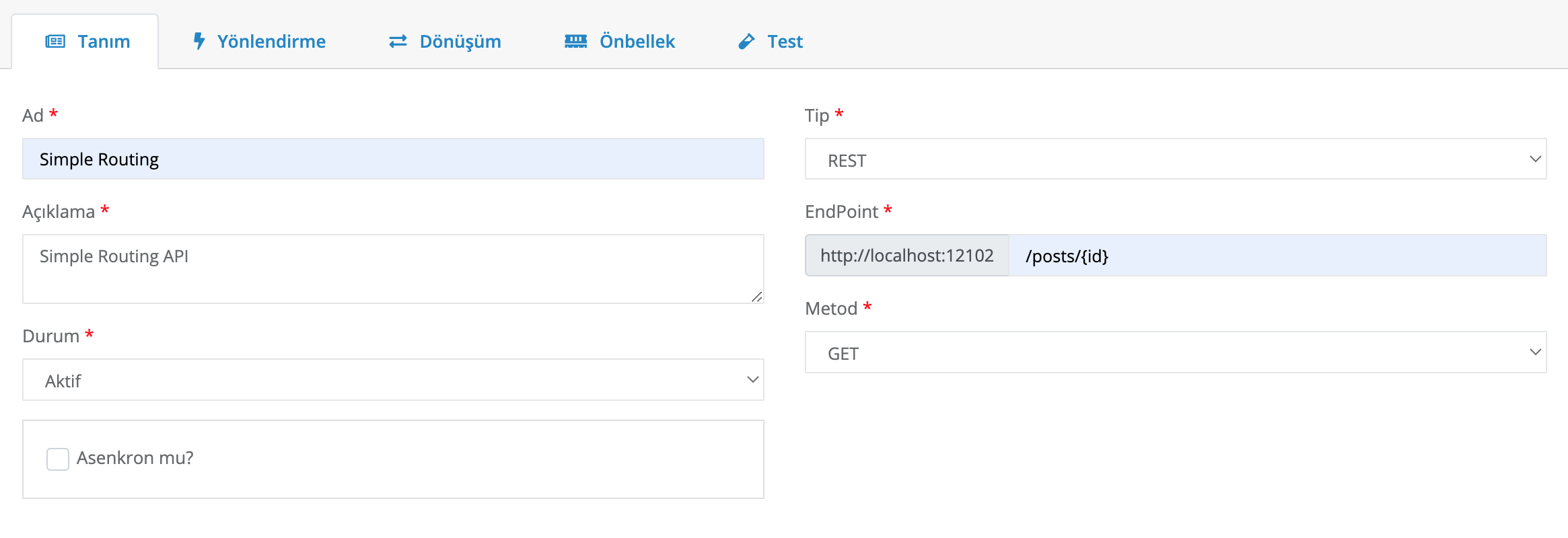
Yönlendirme sekmesine tıklanır ve Basit Yönlendirme seçilir.
Aşağıdaki bilgiler doldurulur:
Backend Http Metot: GET
BackendUri: https://jsonplaceholder.typicode.com/posts/{id} (Oluşturulan API’nin yönlendirileceği URI)

Önbellek sekmesine tıklanır.
Önbelleği aktifleştir kutucuğu işaretlenir ve aşağıdaki alanlar doldurulur:
Önbellek Zamanaşımı (Saniye): 20
Başarı Kuralı:
-
Backend Protokolü: HTTP
-
Kural Tipi: HTTP Durumu
-
En Küçük Değer: 200
-
En Büyük Değer: 226
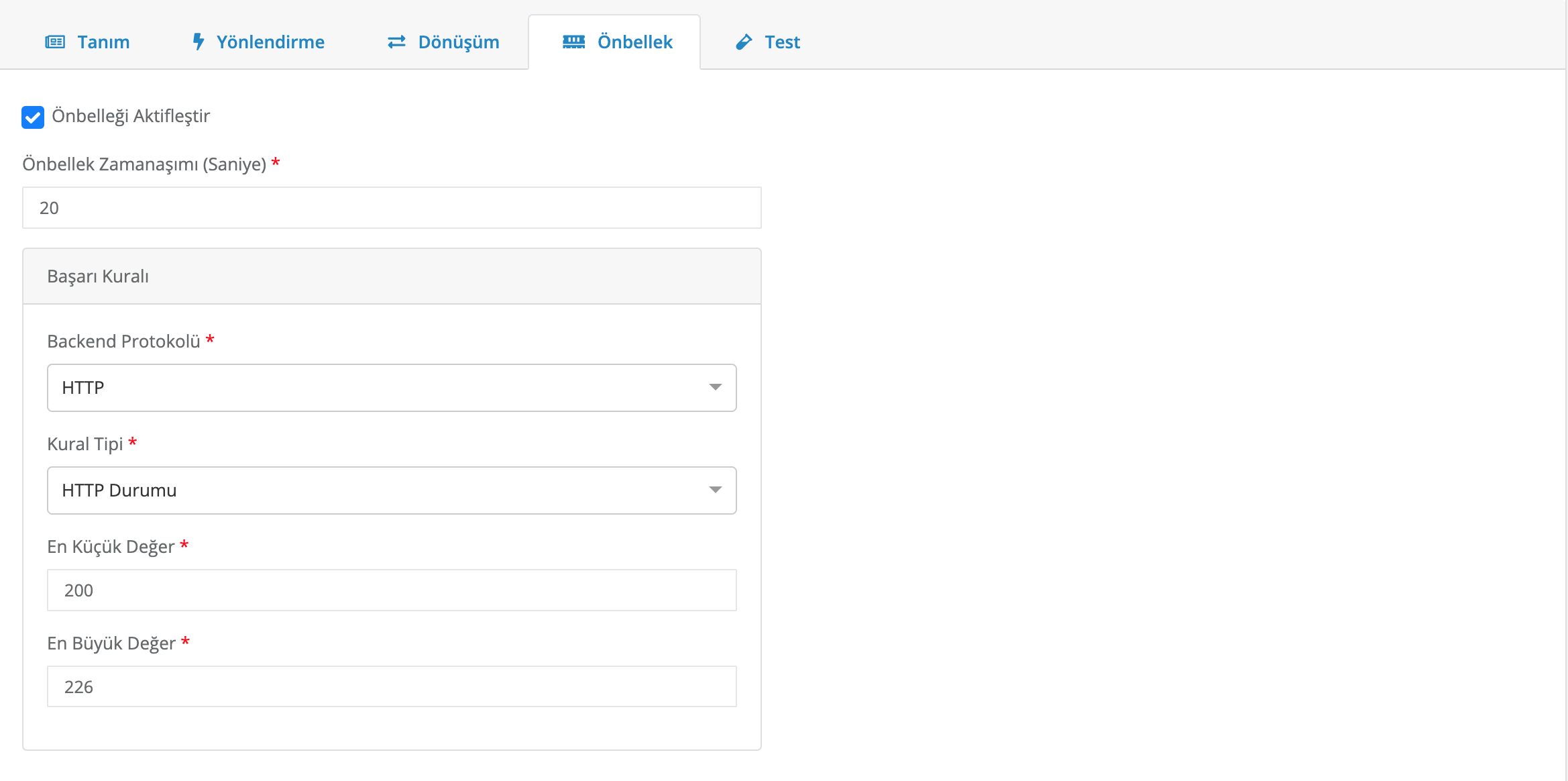
Kaydet butonuna tıklanır.
-
Test
Uygulamaya giriş yapılır.
Sol menüden Katalog altında bulunan API'ye tıklanır.
Oluşturulan API’nin güncelle butonuna tıklanır.
Test sekmesine tıklanır.
İstek → Parametreler → Path Parametreleri bölümünde id anahtarının karşısına bir değer girilir, örneğin 1.
Çalıştır’a tıklanır.
API’den dönen cevap görülür.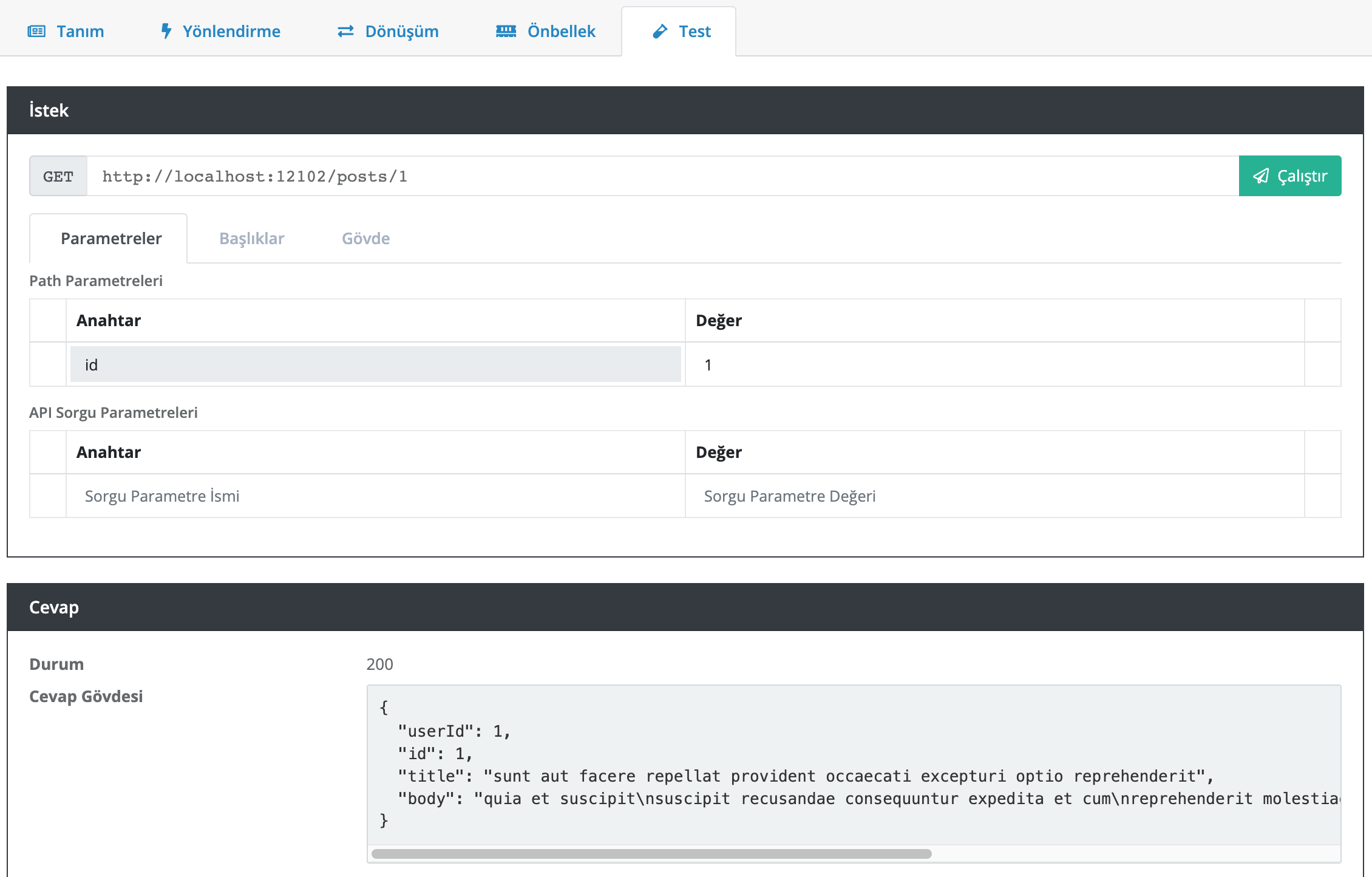 Figure 4. Basit Yönlendirme Test
Figure 4. Basit Yönlendirme TestServis gateway üzerinden tetiklendiğinde başarıyla backend API tetiklenir.
Servis 20 saniye içerisinde tekrar aynı parametreler ile tetiklendiğinde backend API tetiklenmez. Önbellekteki cevabın başarı ile dönüldüğü gözlemlenir.
20 saniye geçtikten sonra servis aynı parametreler ile tetiklendiğinde backend API’nin çağırıldığı gözlemlenir.
Farklı URL parametreleri ile servis tetiklendiğinde önbellekteki değerin dönülmediği görülür.
Round Robin Yük Dağıtımı
Tüm backend’lerin aynı kapasitede ve özelliklerde olduğu durumda, isteklerin sırayla farklı backend’lere gönderilmesi için kullanılır.
API Oluşturma ve Test
Uygulamaya giriş yapılır.
Sol menüden Katalog altında bulunan API'ye tıklanır.
Yeni API Oluştur butonuna tıklanır.
Tanım sekmesinde aşağıdaki bilgiler doldurulur:
Ad: Round Robin Load Balancing
Açıklama: Round Robin Load Balancing API
Durum: Aktif
Tip: REST
EndPoint: /round-robin
Metot: GET
Asenkron mu?: Hayır

Yönlendirme sekmesine tıklanır ve Yük Dağıtımı ile Yönlendirme seçilir.
Yük dağıtım stratejisi olarak Round Robin seçilir.
Backend’de rest/gets/v10/first API’si olduğu varsayılır. Aynı backend farklı portlarda (12107, 12109, 12110) ya da farklı sunucularda aynı portta birden fazla instance olarak ayağa kaldırılır.
Backend URL ekleme butonuna tıklanır.
Aşağıdaki bilgiler doldurulur:
Backend URL: http://localhost:12107/rest/gets/v10/first (İsteklerin gönderileceği URL)
Backend URL: http://localhost:12109/rest/gets/v10/first
Backend URL: http://localhost:12110/rest/gets/v10/first

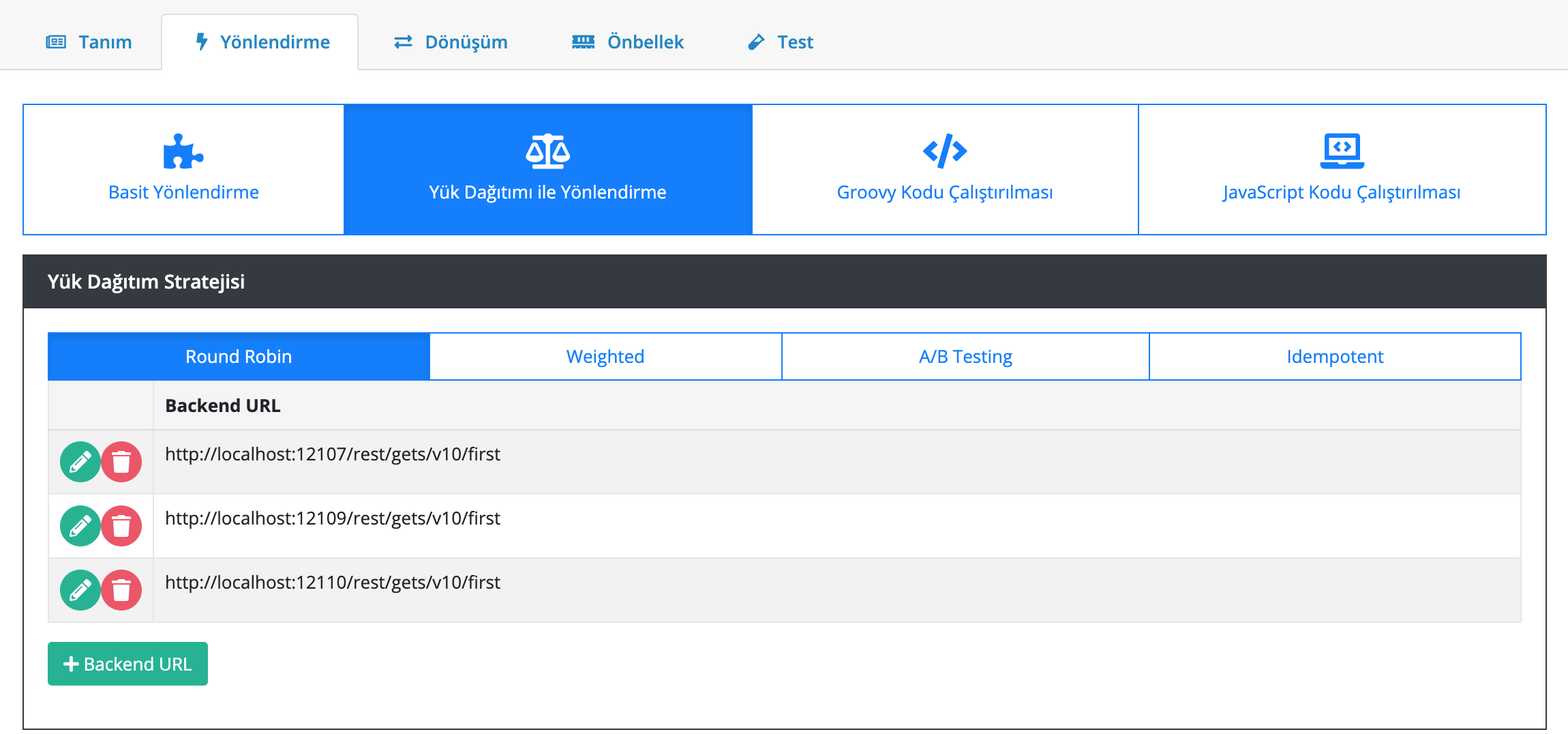
Backend Http Metot GET seçilir.
Kaydet butonuna tıklanır.
-
Test
Uygulamaya giriş yapılır.
Sol menüden Katalog altında bulunan API'ye tıklanır.
Oluşturulan API’nin güncelle butonuna tıklanır.
Test sekmesine tıklanır.
Çalıştır’a tıklanır.Çalıştır butonuna her tıklandığında isteklerin sırayla farklı backend’lere gönderildiği görülür.
Ağırlıklı Yük Dağıtımı
Yükün belirli oranlarda backend URL’lere dağıtılmasını sağlar. Örneğin gelen trafiğin %25’inin bir backend’e, %75’inin başka bir backend’e iletilmesi sağlanabilir.
API Oluşturma ve Test
Uygulamaya giriş yapılır.
Sol menüden Katalog altında bulunan API'ye tıklanır.
Yeni API Oluştur butonuna tıklanır.
Tanım sekmesinde aşağıdaki bilgiler doldurulur:
Ad: Weighted Load Balancing
Açıklama: Weighted Load Balancing API
Durum: Aktif
Tip: REST
EndPoint: /weighted
Metot: GET
Asenkron mu?: Hayır
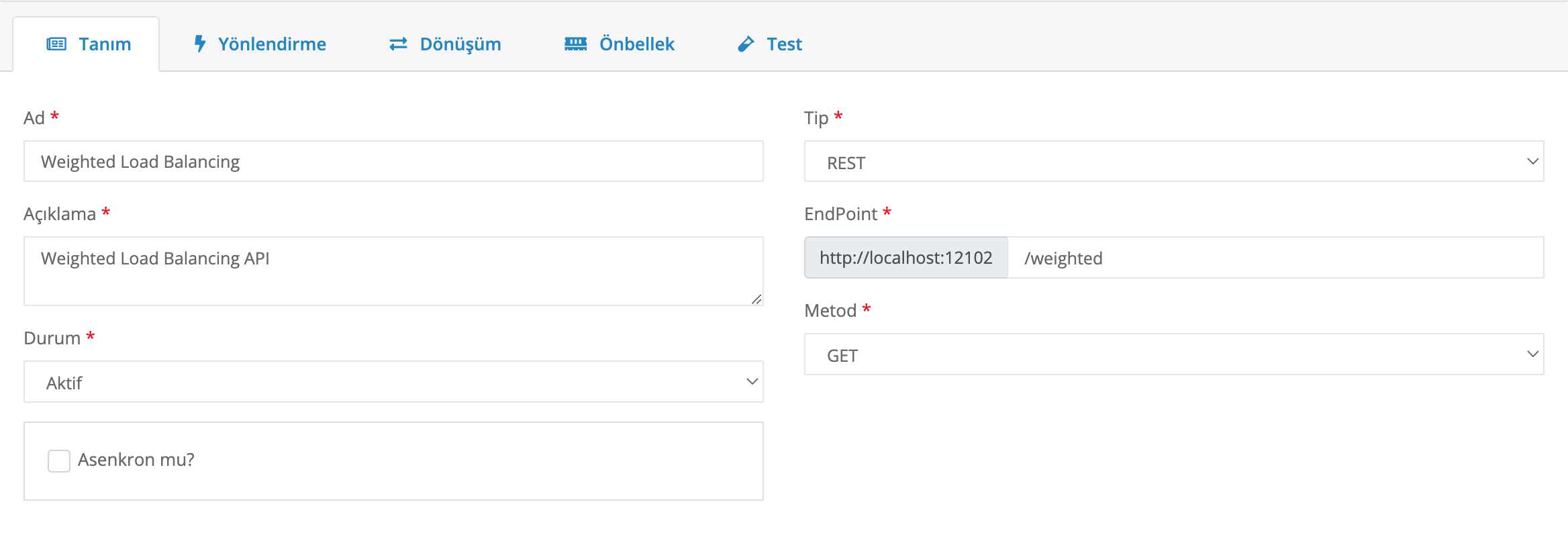
Yönlendirme sekmesine tıklanır ve Yük Dağıtımı ile Yönlendirme seçilir.
Yük dağıtım stratejisi olarak Weighted seçilir.
Backend’de rest/gets/v10/first API’si olduğu varsayılır. Aynı backend farklı portlarda (12107, 12109) ya da farklı sunucularda aynı portta birden fazla instance olarak ayağa kaldırılır.
Backend URL ekleme butonuna tıklanır.
Aşağıdaki bilgiler doldurulur:
Backend URL: http://localhost:12107/rest/gets/v10/first (İsteklerin gönderileceği URL)
Ağırlık: 1 (Backend’e gidecek isteklerin oranı)
Backend URL: http://localhost:12109/rest/gets/v10/first
Ağırlık: 3
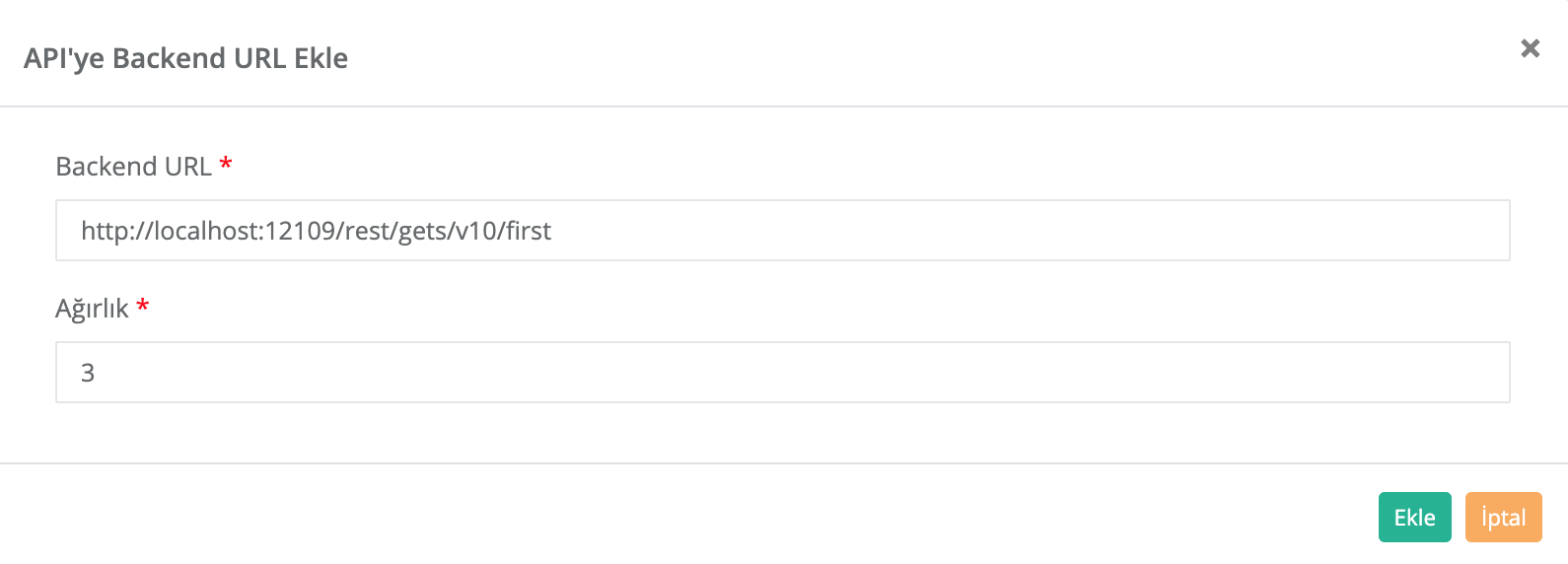
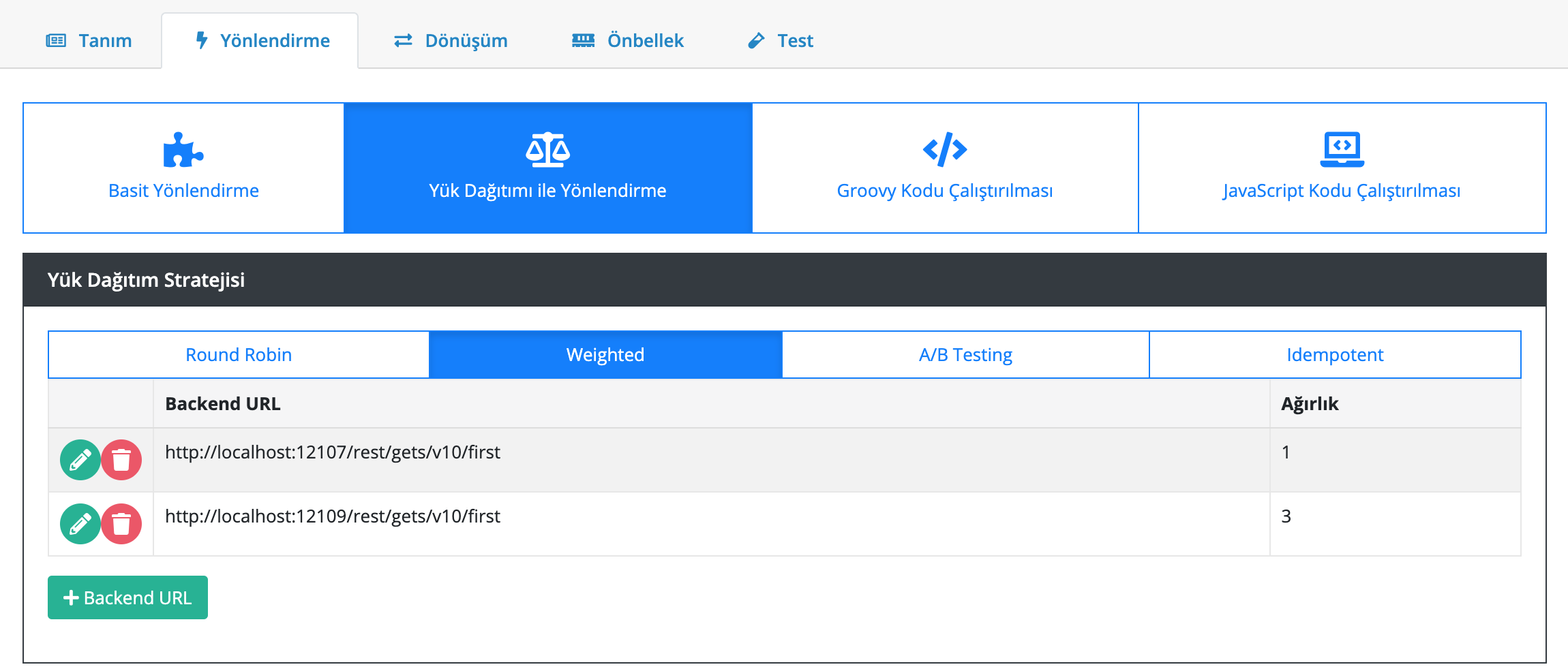
Backend Http Metot GET seçilir.
Kaydet butonuna tıklanır.
-
Test
Uygulamaya giriş yapılır.
Sol menüden Katalog altında bulunan API'ye tıklanır.
Oluşturulan API’nin güncelle butonuna tıklanır.
Test sekmesine tıklanır.
Çalıştır’a tıklanır.Çalıştır butonuna tıklandığında isteklerin backend’lere 1 - 3 oranında dağıldığı görülür. Mesela 100 istek atıldığını varsayalım. 25 istek bir backend’e gönderilirken 75 istek diğer backend’e gönderilir.
A/B Test
Belirli kriterlere göre seçilmiş belirli bir grubu her zaman aynı backend URL’ine göndermek için kullanılır. Örneğin bir mikroservisin yeni devreye alınmış bir versiyonu ile eski versiyonu aynı anda ayakta olduğu durumda, sadece belli müşterileri seçerek bu müşterilerin API isteklerini yeni versiyona, diğer müşterilerin isteklerini eski versiyona iletmek için kullanılabilir.
API Oluşturma ve Test
Uygulamaya giriş yapılır.
Sol menüden Katalog altında bulunan API'ye tıklanır.
Yeni API Oluştur butonuna tıklanır.
Tanım sekmesinde aşağıdaki bilgiler doldurulur:
Ad: A/B Testing
Açıklama: A/B Testing
Durum: Aktif
Tip: REST
EndPoint: /ab
Metot: GET
Asenkron mu?: Hayır

Yönlendirme sekmesine tıklanır ve Yük Dağıtımı ile Yönlendirme seçilir.
Yük dağıtım stratejisi olarak A/B Testing seçilir.
Backend’de rest/gets/v10/first API’si olduğu varsayılır. Aynı backend farklı portlarda (12107, 12109) ya da farklı sunucularda aynı portta birden fazla instance olarak ayağa kaldırılır.
Backend URL ekleme butonuna tıklanır.
-
Değer kaynağının İstek Başlığı seçildiği durum:
Aşağıdaki bilgiler doldurulur:
Backend URL:
http://localhost:12107/rest/gets/v10/first
Değer Kaynağı: İstek Başlığı
İstek Başlığı İsmi:X-Forwarded-For
Beklenen Değer:88.11.23.35
Değer Operatörü: Eşittir
Default Backend: HayırBackend URL:
http://localhost:12109/rest/gets/v10/first
Değer Kaynağı: İstek Başlığı
İstek Başlığı İsmi:X-Forwarded-For
Beklenen Değer:88.11.23.35
Değer Operatörü: Eşit değildir
Default Backend: Evet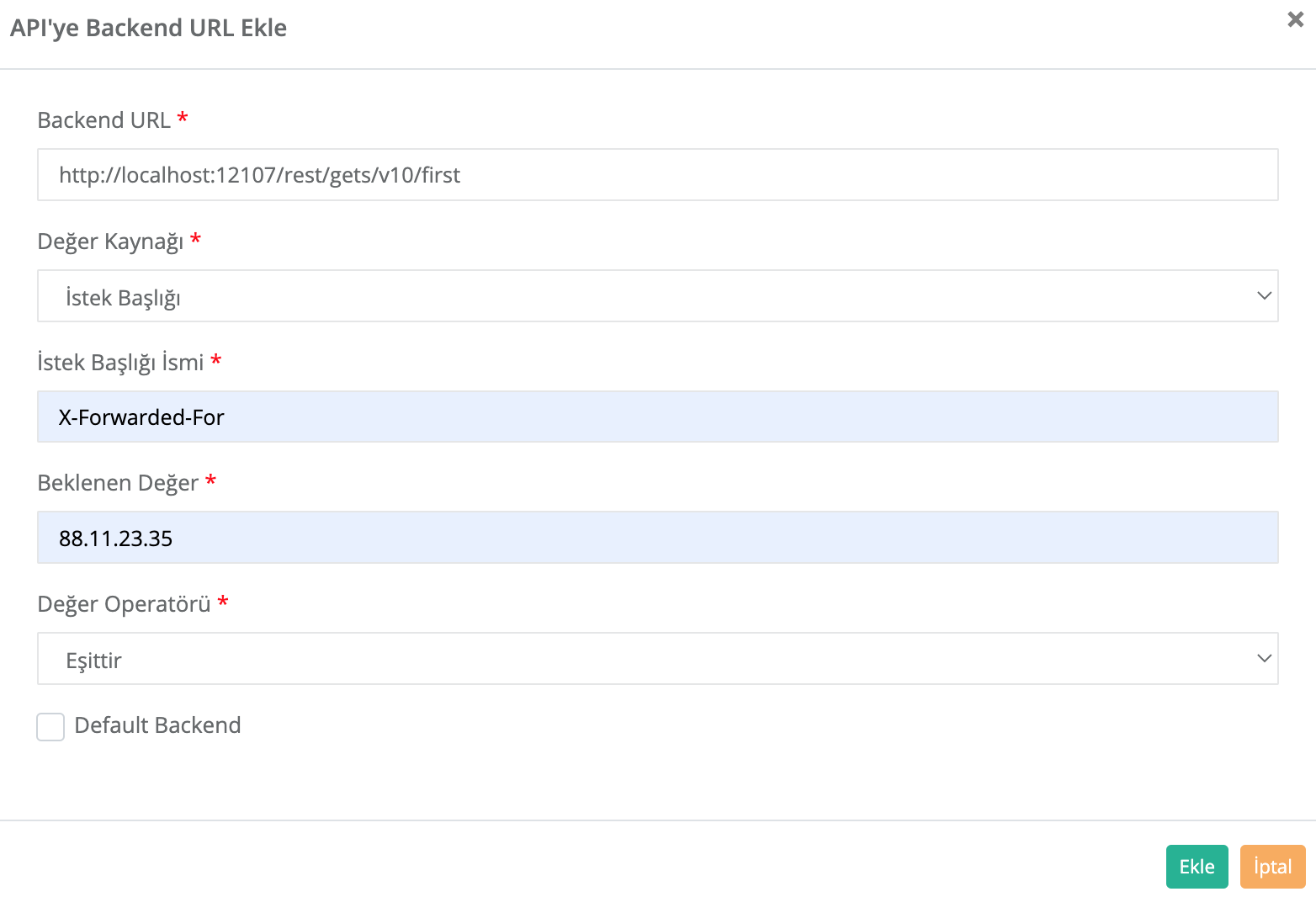 Figure 12. Backend URL Ekleme
Figure 12. Backend URL Ekleme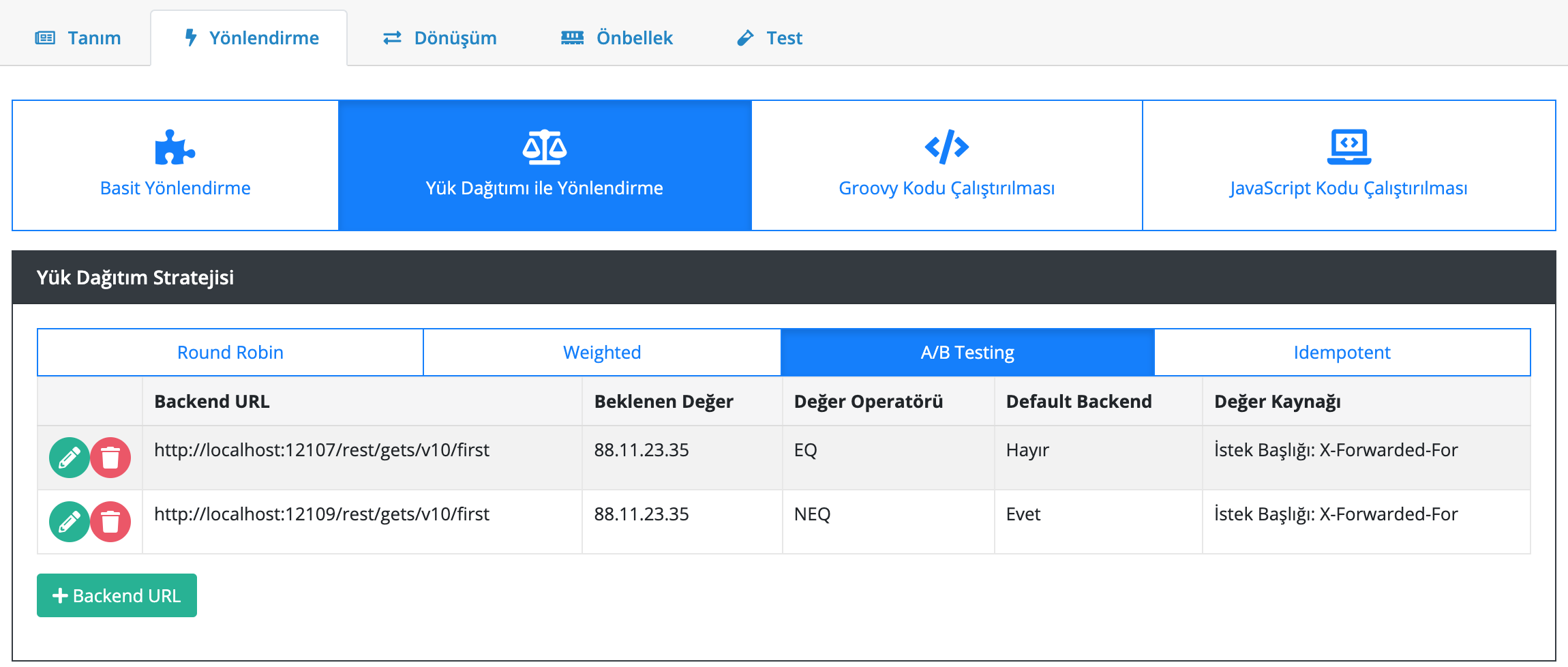 Figure 13. Yönlendirme
Figure 13. YönlendirmeBackend Http Metot GET seçilir.
Kaydet butonuna tıklanır.-
Test
Uygulamaya giriş yapılır.
Sol menüden Katalog altında bulunan API'ye tıklanır.
Oluşturulan API’nin güncelle butonuna tıklanır.
Test sekmesine tıklanır.
İstek → Başlıklar → API İsteği Başlıkları bölümünde X-Forwarded-For anahtarının karşısına 88.11.23.35 değeri girilir. Çalıştır’a tıklanır.
Atılan isteğin 12107 portlu backend’e gönderildiği görülür.
X-Forwarded-For anahtarının karşısına farklı bir değer girilir ve çalıştıra tıklanır.
Atılan isteğin 12109 portlu backend’e gönderildiği görülür. -
-
Değer kaynağının Sorgu Dizesi Parametresi seçildiği durum:
Aşağıdaki bilgiler doldurulur:
Backend URL:
http://localhost:12107/rest/gets/v10/first
Değer Kaynağı: Sorgu Dizesi Parametresi
Sorgu Dizesi Parametre Adı:priority
Beklenen Değer:1
Değer Operatörü: Eşittir
Default Backend: HayırBackend URL:
http://localhost:12109/rest/gets/v10/first
Değer Kaynağı: Sorgu Dizesi Parametresi
Sorgu Dizesi Parametre Adı:priority
Beklenen Değer:1
Değer Operatörü: Eşit değildir
Default Backend: Evet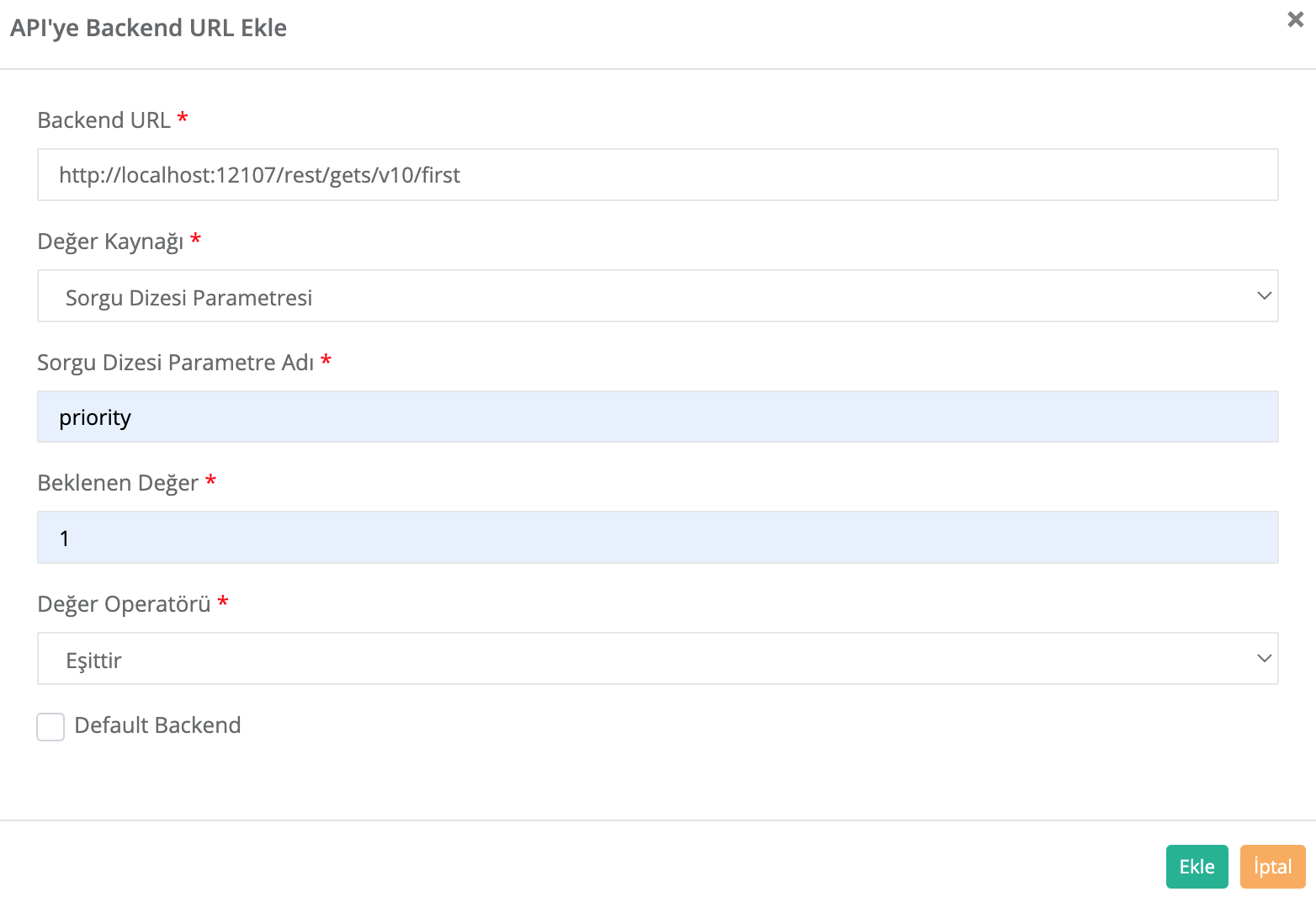 Figure 14. Backend URL Ekleme
Figure 14. Backend URL Ekleme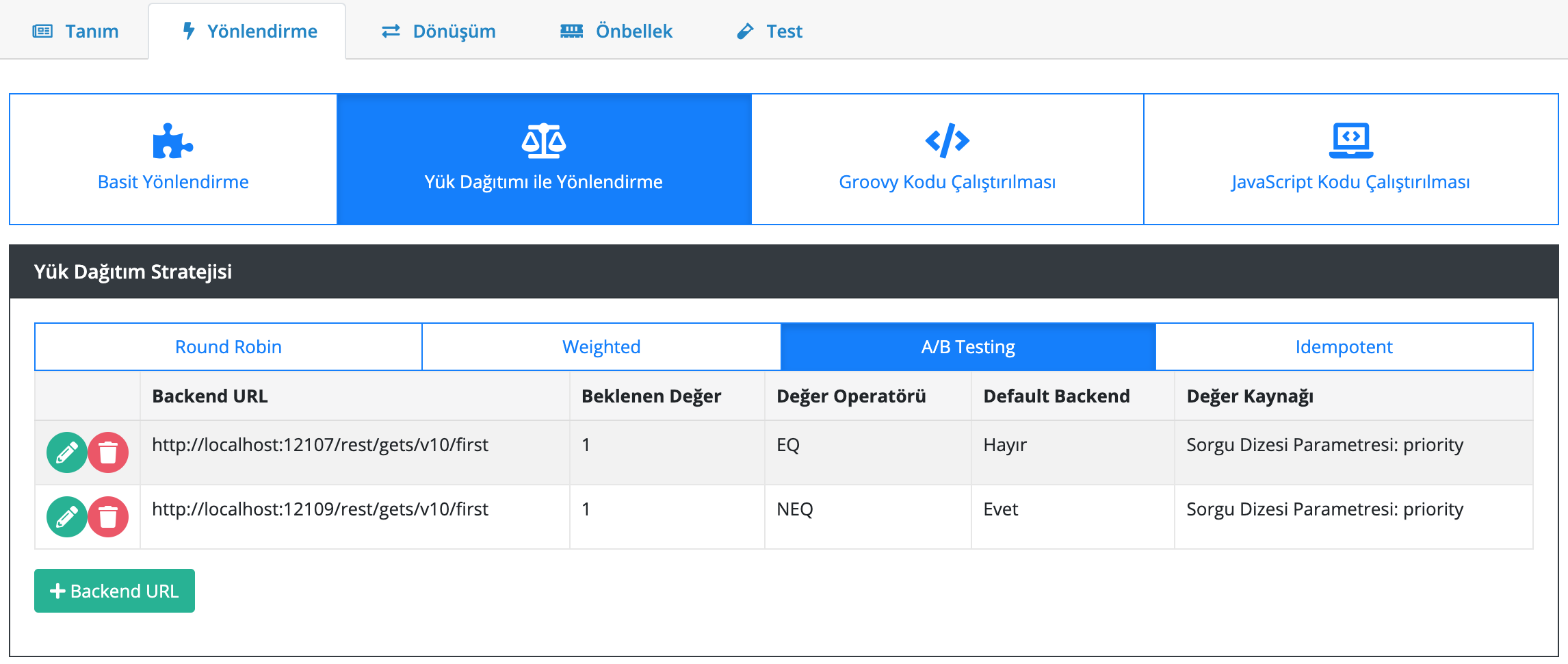 Figure 15. Yönlendirme
Figure 15. YönlendirmeBackend Http Metot GET seçilir.
Kaydet butonuna tıklanır.-
Test
Uygulamaya giriş yapılır.
Sol menüden Katalog altında bulunan API'ye tıklanır.
Oluşturulan API’nin güncelle butonuna tıklanır.
Test sekmesine tıklanır.
İstek → Parametreler → API Sorgu Parametreleri bölümünde priority anahtarının karşısına 1 değeri girilir. Çalıştır’a tıklanır.
Atılan isteğin 12107 portlu backend’e gönderildiği görülür.
priority anahtarının karşısına farklı bir değer girilir ve çalıştıra tıklanır.
Atılan isteğin 12109 portlu backend’e gönderildiği görülür. -
-
Değer kaynağının İstek Gövdesi JsonPath seçildiği durum:
Aşağıdaki bilgiler doldurulur:
Backend URL:
http://localhost:12107/rest/gets/v10/first
Değer Kaynağı: İstek Gövdesi JsonPath
JSON Path:$.msisdn
Beklenen Değer:905554443322
Değer Operatörü: Eşittir
Default Backend: HayırBackend URL:
http://localhost:12109/rest/gets/v10/first
Değer Kaynağı: İstek Gövdesi JsonPath
JSON Path:$.msisdn
Beklenen Değer:905554443322
Değer Operatörü: Eşit değildir
Default Backend: Evet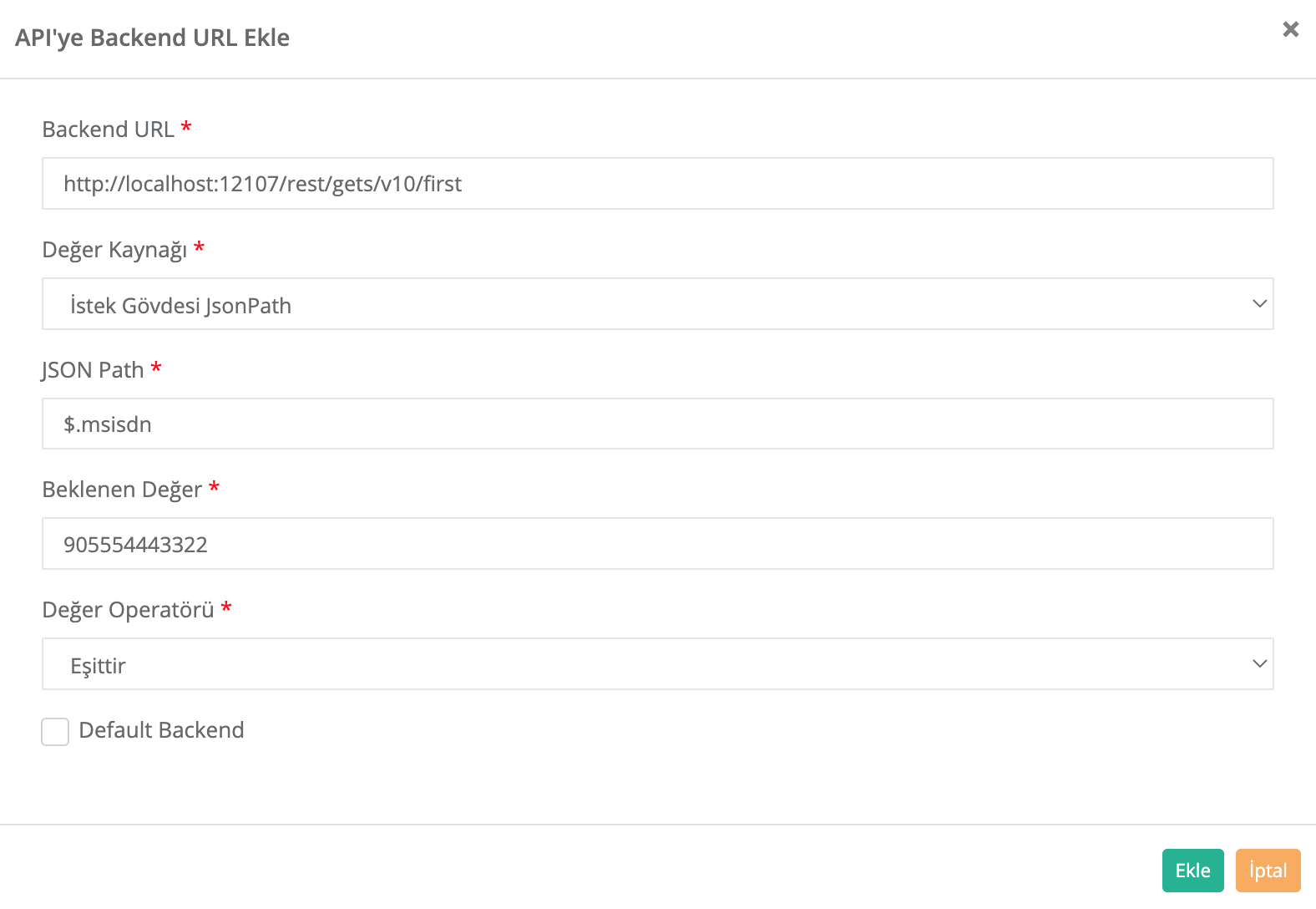 Figure 16. Backend URL Ekleme
Figure 16. Backend URL Ekleme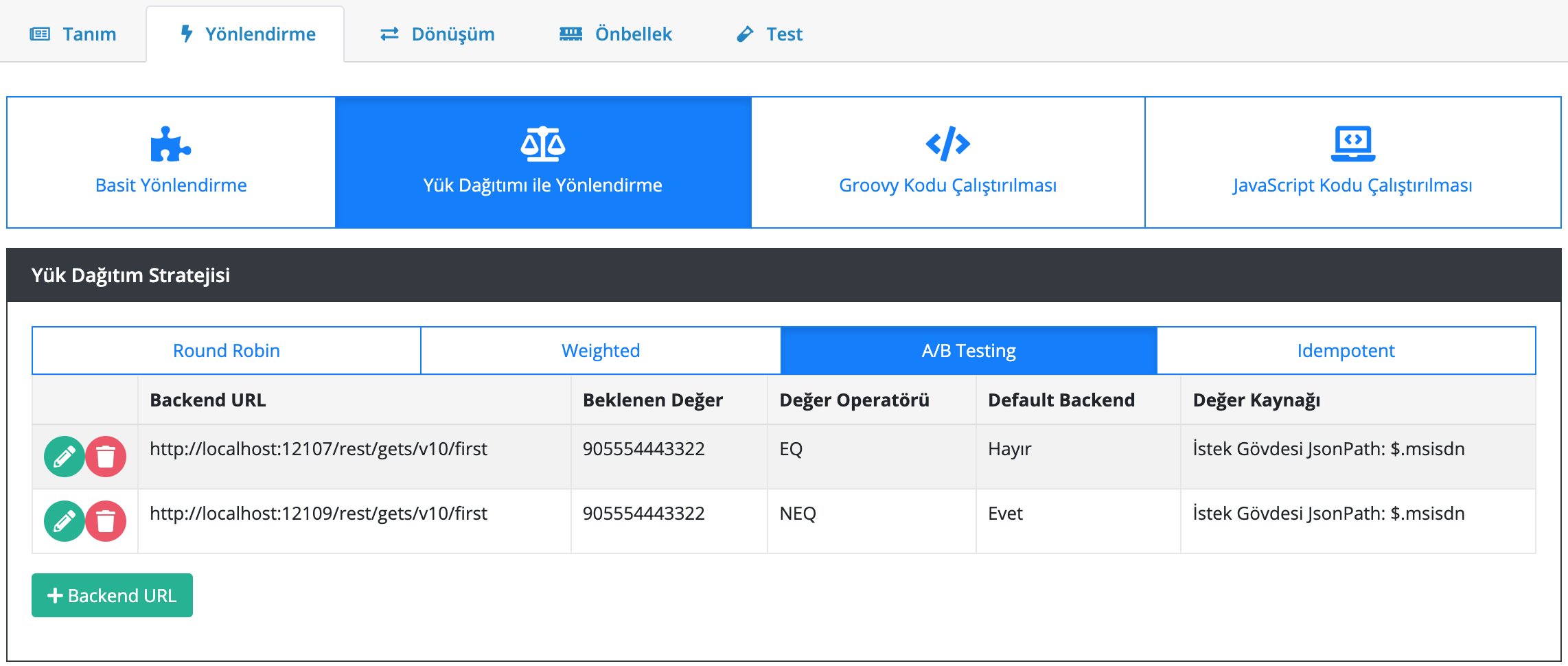 Figure 17. Yönlendirme
Figure 17. YönlendirmeBackend Http Metot GET seçilir.
Kaydet butonuna tıklanır.-
Test
Postman veya benzeri bir REST client üzerinden aşağıdaki gibi bir istek oluşturulur.
Gövde kısmına aşağıdaki json değeri girilir vehttp://localhost:12102/abURL’ine istek atılır.{ "offerKey": "OFR1234", "msisdn": "905554443322" }Atılan isteğin 12107 portlu backend’e gönderildiği görülür.
msisdn parametresinin karşısına farklı bir değer girilir ve istek atılır.
Atılan isteğin 12109 portlu backend’e gönderildiği görülür. Figure 18. A/B Testing
Figure 18. A/B Testing -
-
Değer kaynağının İstek Gövdesi XPath seçildiği durum:
-
API Oluşturma
Uygulamaya giriş yapılır.
Sol menüden Katalog altında bulunan API'ye tıklanır.
Yeni API Oluştur butonuna tıklanır.
Tanım sekmesinde aşağıdaki bilgiler doldurulur:Ad: A/B Testing
Açıklama: A/B Testing
Durum: Aktif
Tip: SOAP
EndPoint:/ab
Metot: getGenres
Asenkron mu?: Hayır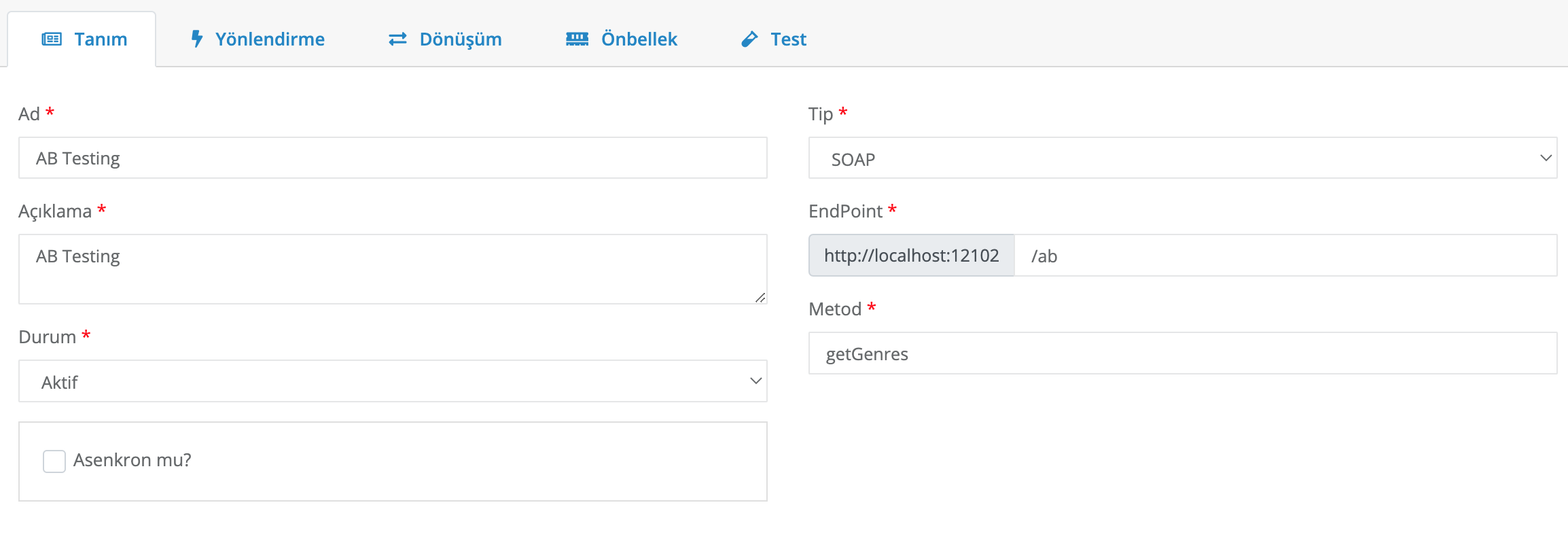 Figure 19. API Oluşturma
Figure 19. API OluşturmaAşağıdaki bilgiler doldurulur:
Backend URL:
http://localhost:12107/soap/posts/v10/first
Değer Kaynağı: İstek Gövdesi XPath
XPath:Envelope/Body/getGenres/username[text()]
Beklenen Değer:ttm_ios
Değer Operatörü: Eşittir
Default Backend: HayırBackend URL:
http://localhost:12109/soap/posts/v10/first
Değer Kaynağı: İstek Gövdesi XPath
XPath:Envelope/Body/getGenres/username[text()]
Beklenen Değer:ttm_ios
Değer Operatörü: Eşit değildir
Default Backend: Evet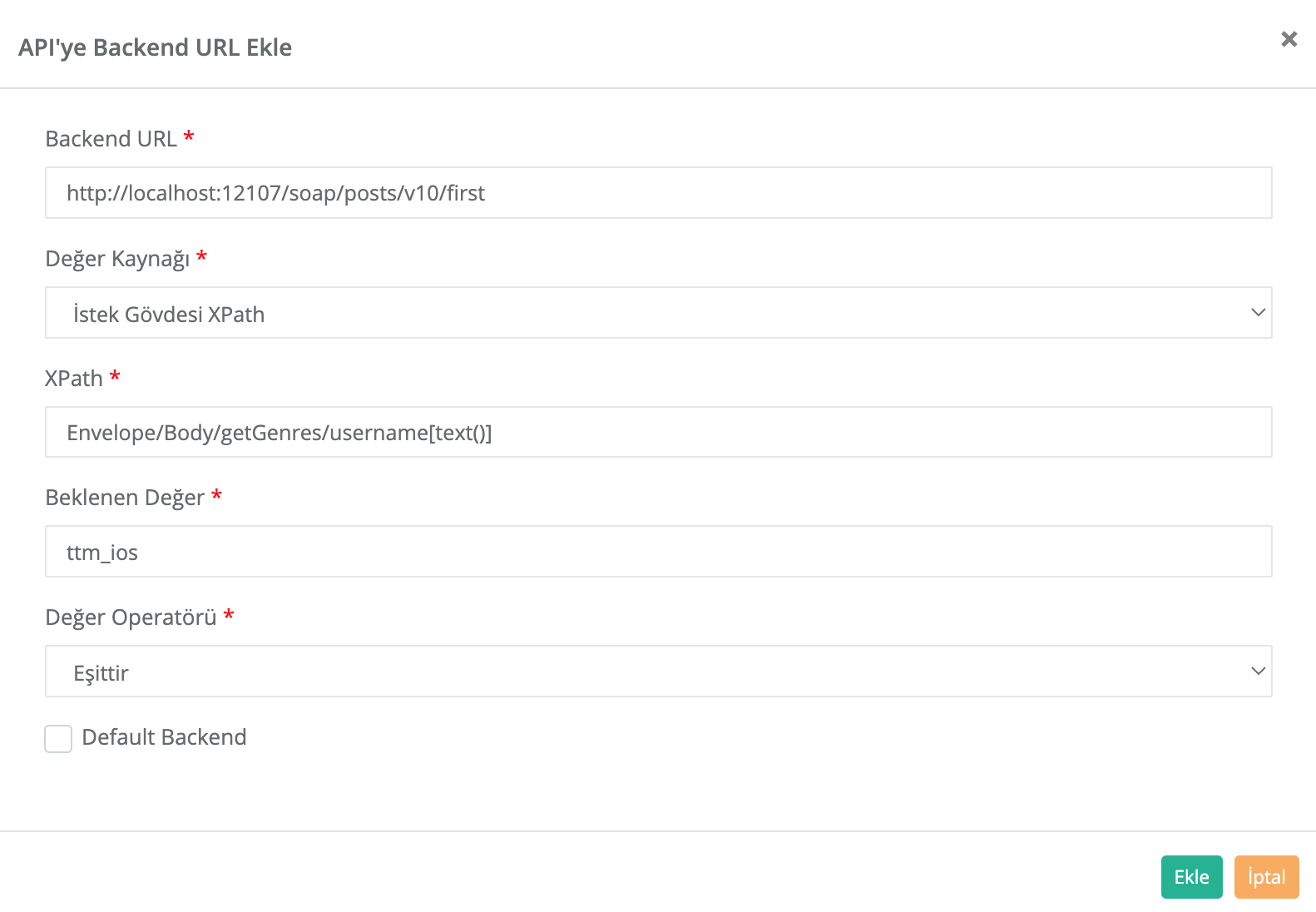 Figure 20. Backend URL Ekleme
Figure 20. Backend URL Ekleme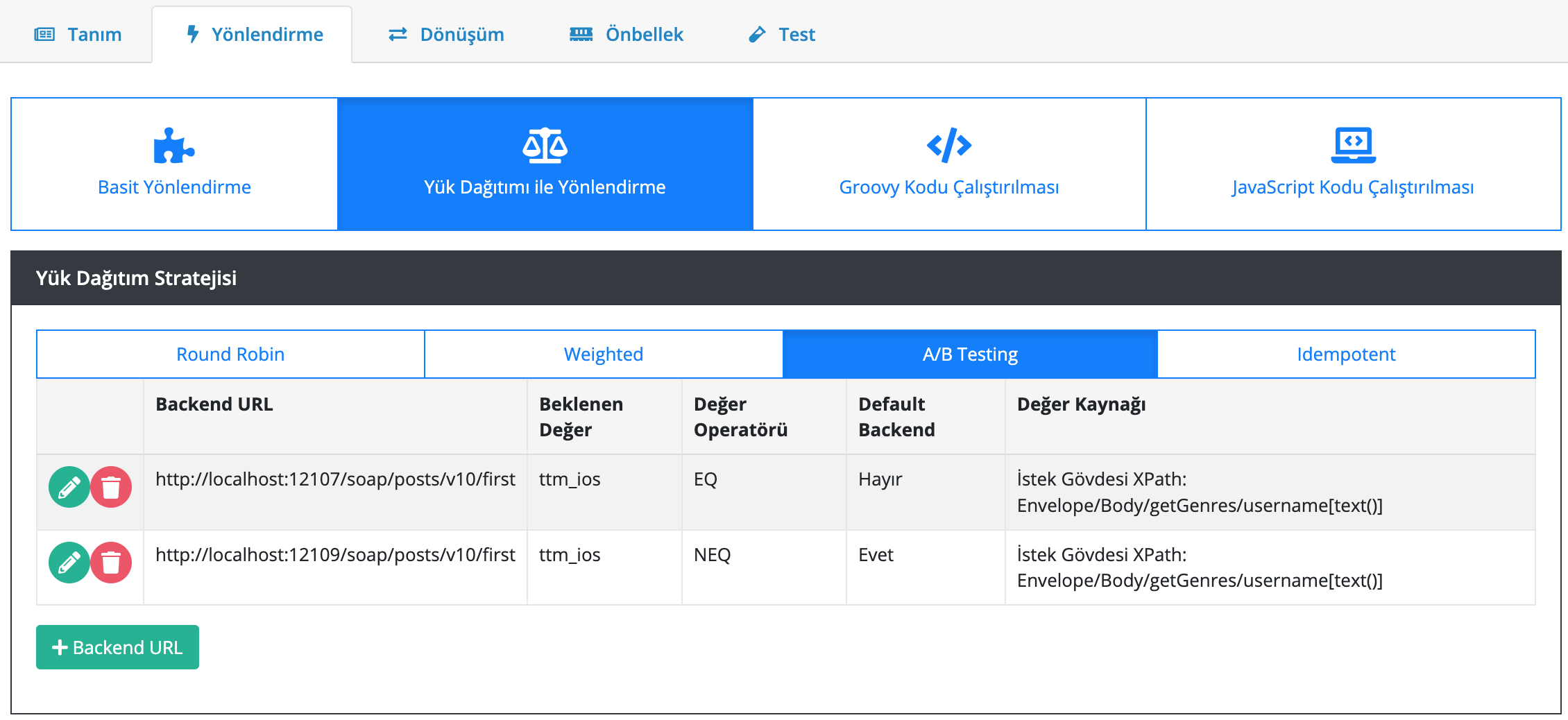 Figure 21. Yönlendirme
Figure 21. YönlendirmeBackend Http Metot POST seçilir.
Kaydet butonuna tıklanır.-
Test
SoapUI veya benzeri bir SOAP Client üzerinden
http://localhost:12102/abURL’ine aşağıdaki istek atılır:<soapenv:Envelope xmlns:soapenv="http://schemas.xmlsoap.org/soap/envelope/" xmlns:wsdl="http://ttmuzikfuncs.proarge.com/wsdl/"> <soapenv:Header/> <soapenv:Body> <wsdl:getGenres> <username>ttm_ios</username> <password>l1st4n_7he_mu5ic!</password> <!--Optional:--> <cdata>1</cdata> </wsdl:getGenres> </soapenv:Body> </soapenv:Envelope>SOAP isteğinde username alanı ttm_ios olan isteklerin 12107 portlu backend’e, username alanı ttm_ios'tan farklı olan isteklerin 12109 portlu backend’e gönderildiği görülür.
-
-
Değer kaynağının İş Nesnesi Alanı seçildiği durum:
Katalog → API Kullanıcıları ekranında tanımlı,
IDdeğeri451fa26738a04a39b95e79fcaf6c6fa2,apiKeydeğerif5a66a64-6e7c-4041-84e7-4d62e96fb7dcolan bir kullanıcı olduğu varsayılıyor.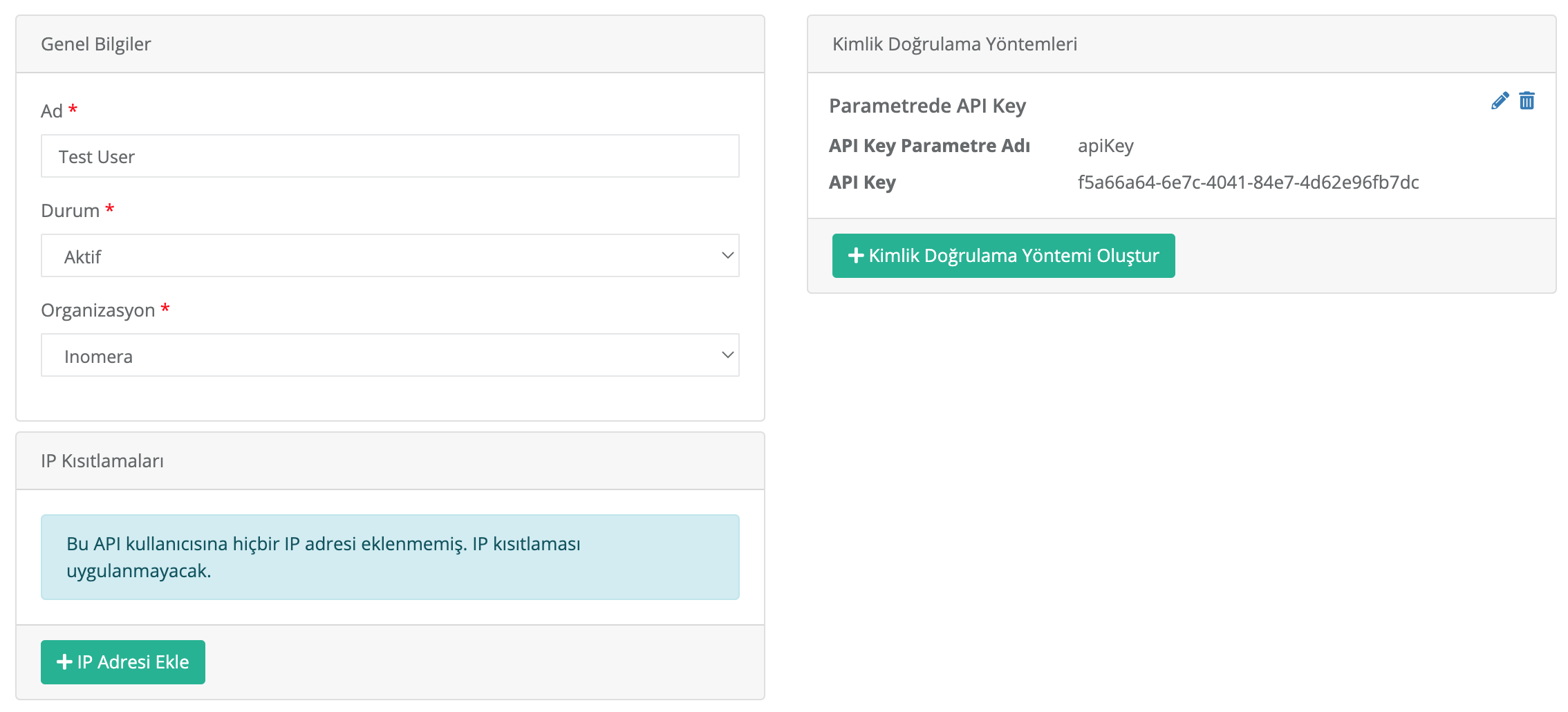 Figure 22. Kimlik Doğrulama Yöntemine Sahip API Kullanıcısı
Figure 22. Kimlik Doğrulama Yöntemine Sahip API KullanıcısıAşağıdaki bilgiler doldurulur:
Backend URL:
http://localhost:12107/rest/gets/v10/first
Değer Kaynağı: İş Nesnesi Alanı
İş Nesnesi Özelliği:API Kullanıcı Id
Beklenen Değer:451fa26738a04a39b95e79fcaf6c6fa2(api kullanıcı id)
Değer Operatörü: Eşittir
Default Backend: HayırBackend URL:
http://localhost:12109/rest/gets/v10/first
Değer Kaynağı: İş Nesnesi Alanı
İş Nesnesi Özelliği:API Kullanıcı Id
Beklenen Değer:451fa26738a04a39b95e79fcaf6c6fa2
Değer Operatörü: Eşit değildir
Default Backend: Evet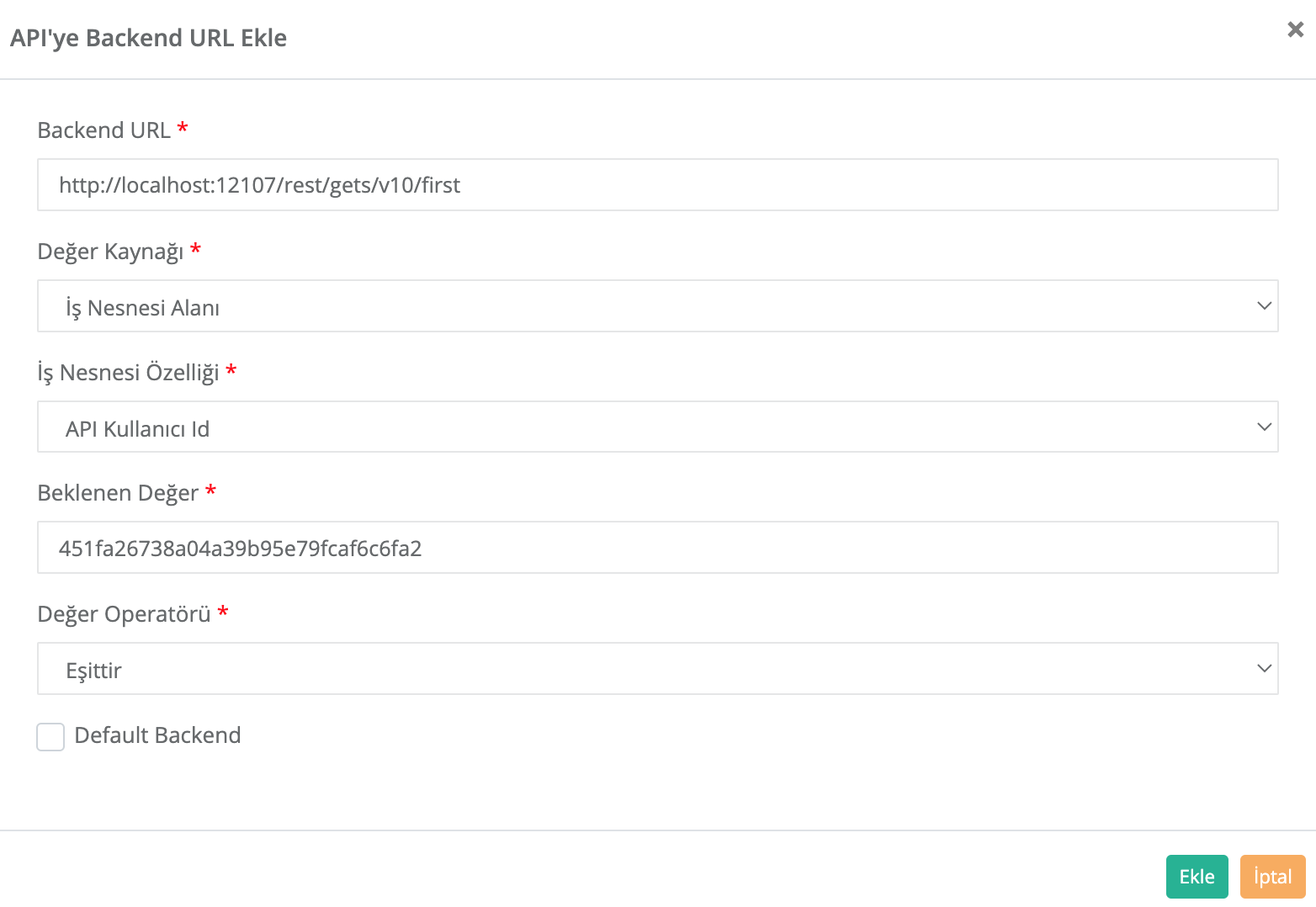 Figure 23. Backend URL Ekleme
Figure 23. Backend URL Ekleme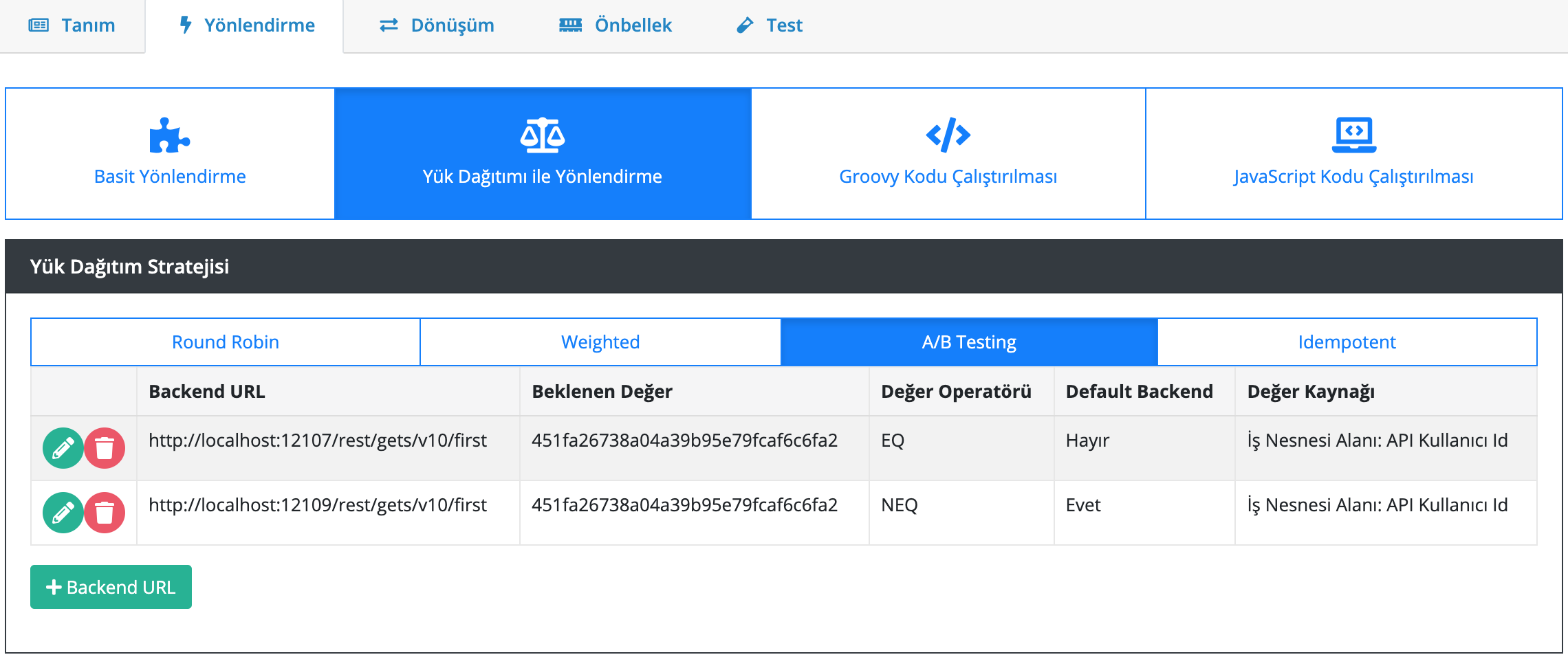 Figure 24. Yönlendirme
Figure 24. YönlendirmeBackend Http Metot GET seçilir.
Kaydet butonuna tıklanır.-
Test
Postman veya benzeri bir REST client üzerinden
http://localhost:12102/ab?apiKey=f5a66a64-6e7c-4041-84e7-4d62e96fb7dcURL’ine istek atılır.
Atılan isteğin 12107 portlu backend’e gönderildiği görülür.
apiKey parametresinin karşısına farklı bir değer girilir ve istek atılır.
Atılan isteğin 12109 portlu backend’e gönderildiği görülür. -
-
Değer kaynağının İş Nesnesi Özelliği seçildiği durum:
Sol menüden Katalog → Katalog Ayarları altında bulunan Özellik Tanımları'na tıklanır.
Özellik Tanımı Oluştur butonuna tıklanır.
Aşağıdaki bilgiler doldurulur:Ad: aggregatorId
Nesne Türü: API Kullanıcısı
Veri Giriş Türü: Tek Satırlı Metin Alanı
Veri Tipi: Metin
Varsayılan Değer: 11
Zorunlu Alan mı?: Hayır
Maksimum Uzunluk: Boş
Düzenli İfade: Boş
Görünüm Sırası: 1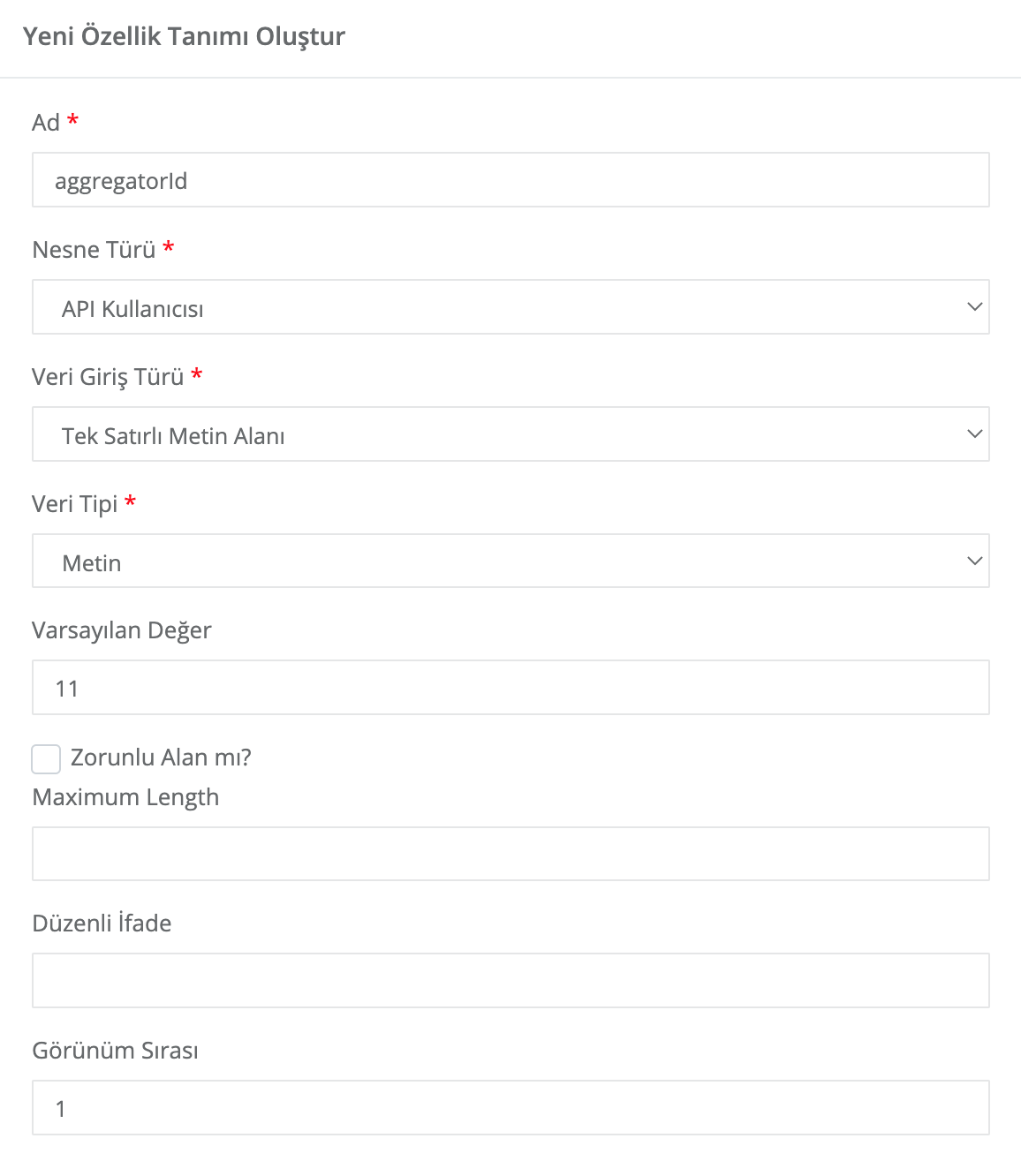 Figure 25. Özellik Tanımı Oluşturma
Figure 25. Özellik Tanımı OluşturmaKaydet butonuna tıklanır.
Sol menüden Katalog altında bulunan API Kullanıcıları'na tıklanır.
apiKey değerif5a66a64-6e7c-4041-84e7-4d62e96fb7dcolan API Kullanıcısının güncelle butonuna tıklanır.
Özellikler sekmesinde bulunanaggregatorIdalanına8değeri girilir.
Güncelle butonuna tıklanır.API oluştururken aşağıdaki bilgiler doldurulur:
Backend URL:
http://localhost:12107/rest/gets/v10/first
Değer Kaynağı: İş Nesnesi Özelliği
Nesne Türü:API Kullanıcısı
Özellik:aggregatorId
Beklenen Değer:8
Değer Operatörü: Eşittir
Default Backend: HayırBackend URL:
http://localhost:12109/rest/gets/v10/first
Değer Kaynağı: İş Nesnesi Özelliği
Nesne Türü:API Kullanıcısı
Özellik:aggregatorId
Beklenen Değer:8
Değer Operatörü: Eşit değildir
Default Backend: Evet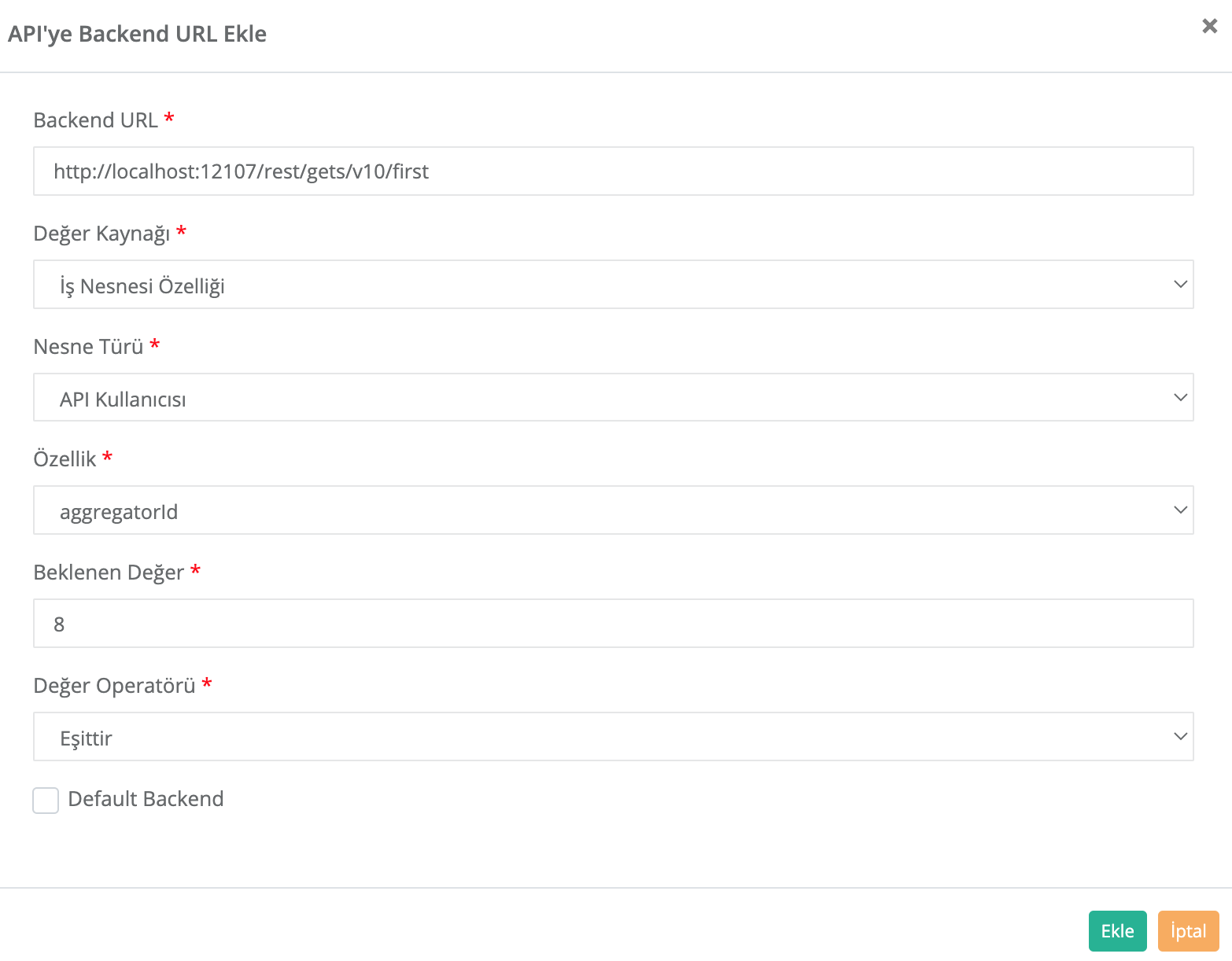 Figure 26. Backend URL Ekleme
Figure 26. Backend URL Ekleme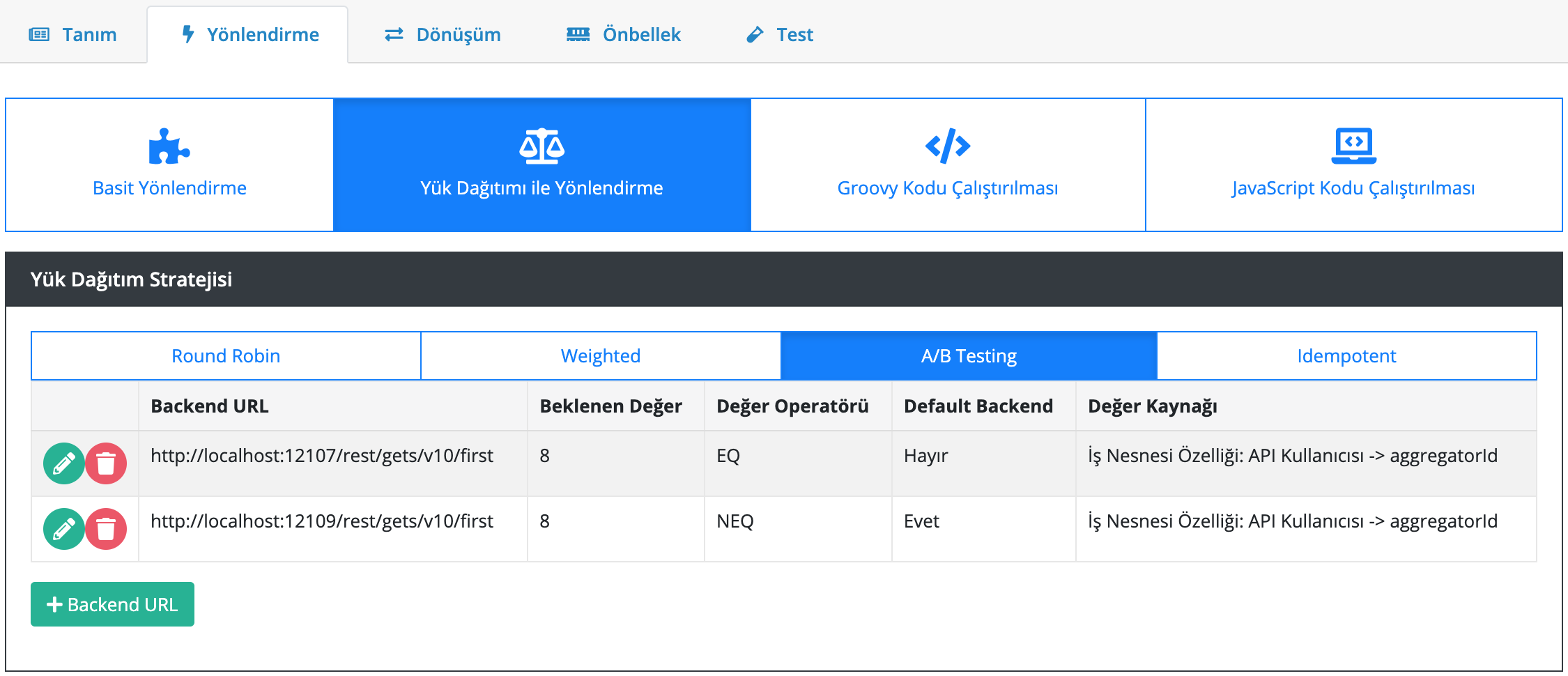 Figure 27. Yönlendirme
Figure 27. YönlendirmeBackend Http Metot GET seçilir.
Kaydet butonuna tıklanır.-
Test
Postman veya benzeri bir REST client üzerinden
http://localhost:12102/ab?apiKey=f5a66a64-6e7c-4041-84e7-4d62e96fb7dcURL’ine istek atılır.
Atılan isteğin 12107 portlu backend’e gönderildiği görülür.
apiKey parametresinin karşısına farklı bir değer girilir ve istek atılır.
Atılan isteğin 12109 portlu backend’e gönderildiği görülür. -
Idempotent Yük Dağıtımı
İsteğin içinden okunabilecek bir değere bağlı olarak, aynı değerdeki isteklerin aynı backend’lere gitmesini sağlar. Bir veya birden fazla Backend URL eklendikten sonra Değer Kaynağı seçimi yapılmalı ve kaynağın ilgili değeri girilmelidir.
API Oluşturma ve Test
Uygulamaya giriş yapılır.
Sol menüden Katalog altında bulunan API'ye tıklanır.
Yeni API Oluştur butonuna tıklanır.
Tanım sekmesinde aşağıdaki bilgiler doldurulur:
Ad: Idempotent Load Balancing
Açıklama: Idempotent Load Balancing
Durum: Aktif
Tip: REST
EndPoint: /idempotent
Metot: GET
Asenkron mu?: Hayır

Yönlendirme sekmesine tıklanır ve Yük Dağıtımı ile Yönlendirme seçilir.
Yük dağıtım stratejisi olarak Idempotent seçilir.
Backend’de rest/gets/v10/first API’si olduğu varsayılır. Aynı backend farklı portlarda (12107, 12109) ya da farklı sunucularda aynı portta birden fazla instance olarak ayağa kaldırılır.
Backend URL ekleme butonuna tıklanır.

-
Değer kaynağının İstek Başlığı seçildiği durum:
Aşağıdaki bilgiler doldurulur:
Backend URL:
http://localhost:12107/rest/gets/v10/firstBackend URL:
http://localhost:12109/rest/gets/v10/firstDeğer Kaynağı: İstek Başlığı
İstek Başlığı İsmi:X-Forwarded-For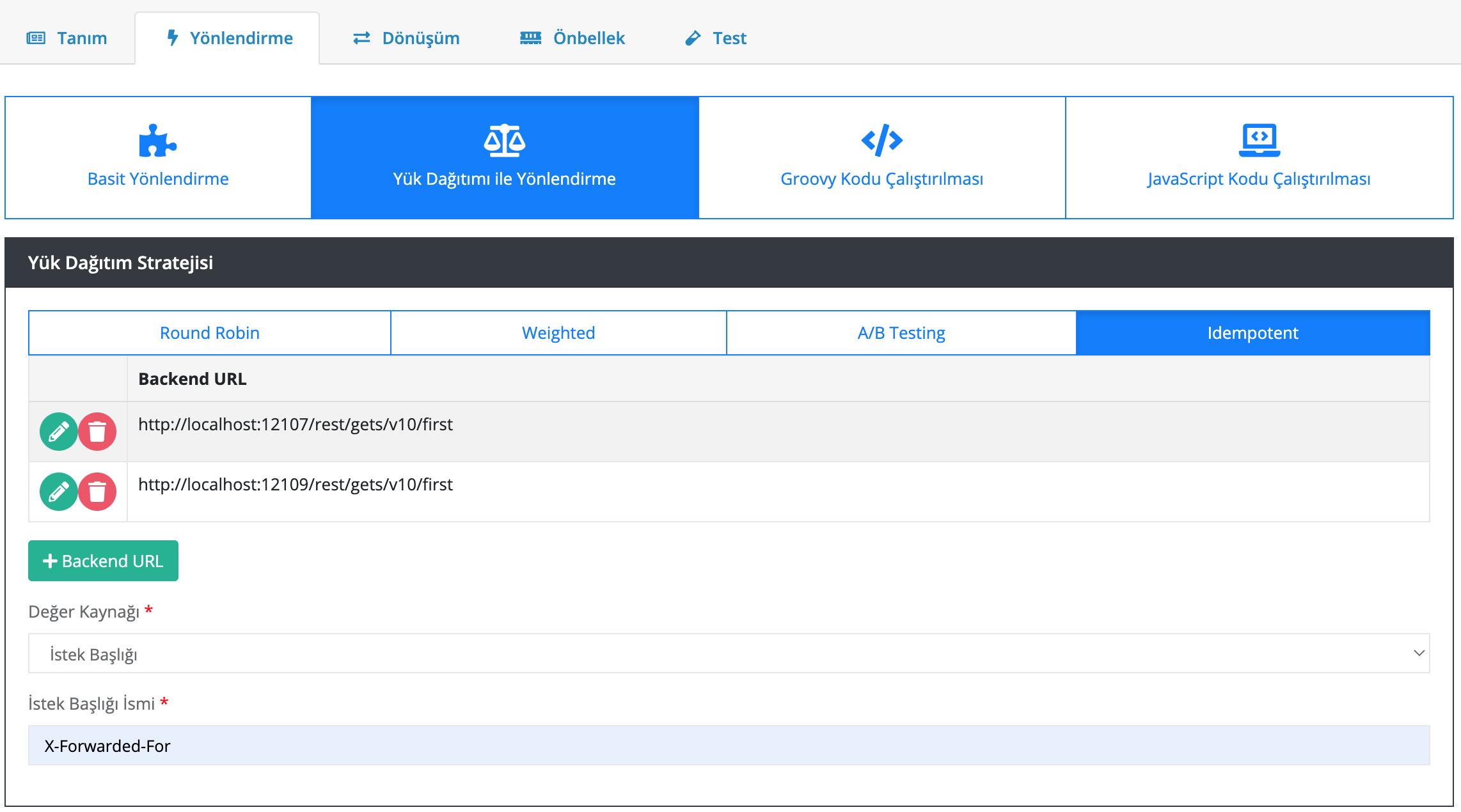 Figure 30. Yönlendirme
Figure 30. YönlendirmeBackend Http Metot GET seçilir.
Kaydet butonuna tıklanır.-
Test
Uygulamaya giriş yapılır.
Sol menüden Katalog altında bulunan API'ye tıklanır.
Oluşturulan API’nin güncelle butonuna tıklanır.
Test sekmesine tıklanır.
İstek → Başlıklar → API İsteği Başlıkları bölümünde X-Forwarded-For anahtarının karşısına 88.11.23.35 değeri girilir. Çalıştır’a tıklanır.
Atılan istek backend’lerden herhangi birine yönlenebilir. İstek başlığı değeri değişmediği sürece isteklerin her zaman aynı backend’e yönlendiği görülür. -
-
Değer kaynağının Sorgu Dizesi Parametresi seçildiği durum:
Aşağıdaki bilgiler doldurulur:
Backend URL:
http://localhost:12107/rest/gets/v10/firstBackend URL:
http://localhost:12109/rest/gets/v10/firstDeğer Kaynağı: Sorgu Dizesi Parametresi
Sorgu Dizesi Parametre Adı:priority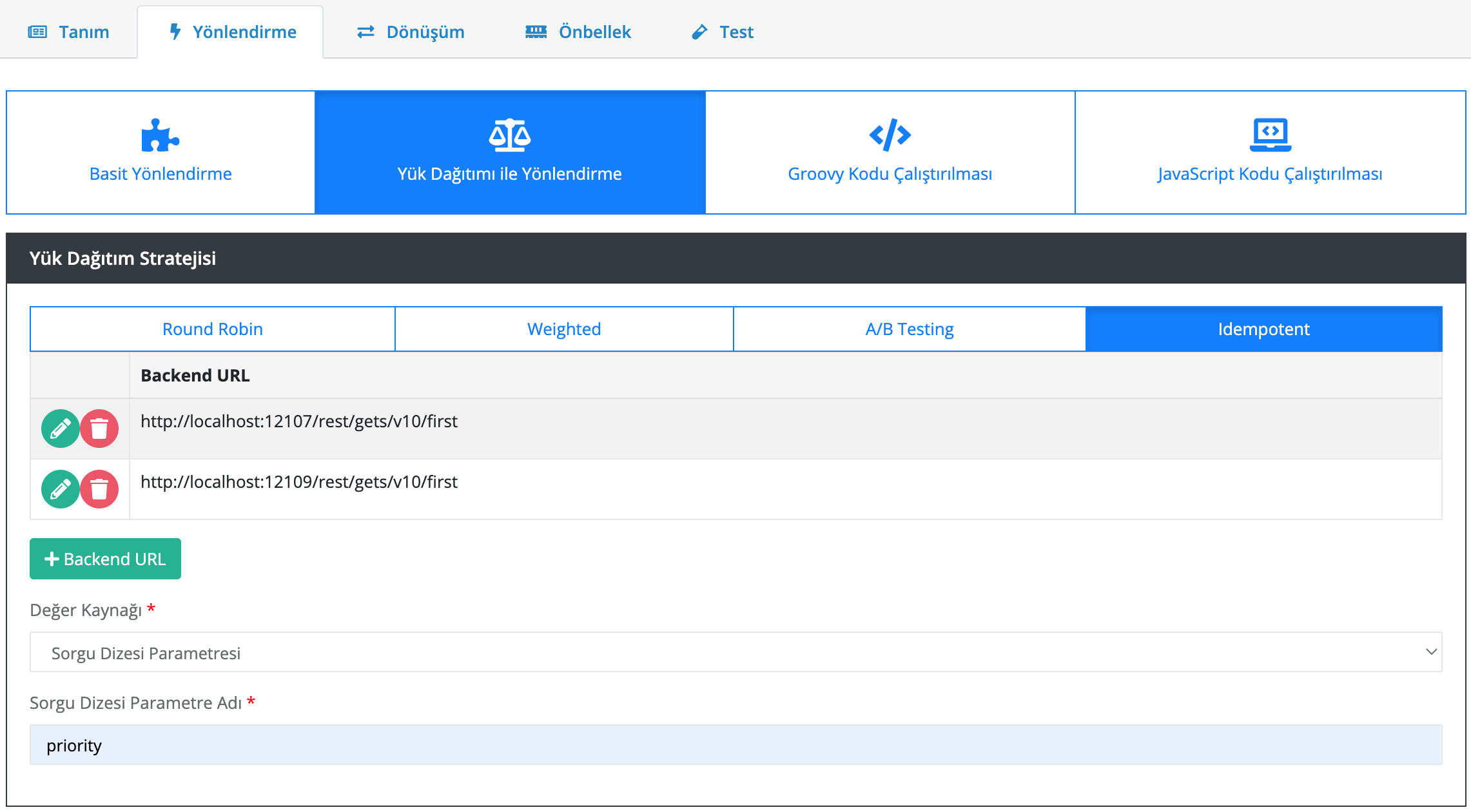 Figure 31. Yönlendirme
Figure 31. YönlendirmeBackend Http Metot GET seçilir.
Kaydet butonuna tıklanır.-
Test
Uygulamaya giriş yapılır.
Sol menüden Katalog altında bulunan API'ye tıklanır.
Oluşturulan API’nin güncelle butonuna tıklanır.
Test sekmesine tıklanır.
İstek → Parametreler → API Sorgu Parametreleri bölümünde priority anahtarının karşısına 1 değeri girilir. Çalıştır’a tıklanır.
Atılan istek backend’lerden herhangi birine yönlenebilir. Sorgu dizesi parametre değeri değişmediği sürece isteklerin her zaman aynı backend’e yönlendiği görülür. -
-
Değer kaynağının İstek Gövdesi JsonPath seçildiği durum:
Aşağıdaki bilgiler doldurulur:
Backend URL:
http://localhost:12107/rest/gets/v10/firstBackend URL:
http://localhost:12109/rest/gets/v10/firstDeğer Kaynağı: İstek Gövdesi JsonPath
JSON Path:$.msisdn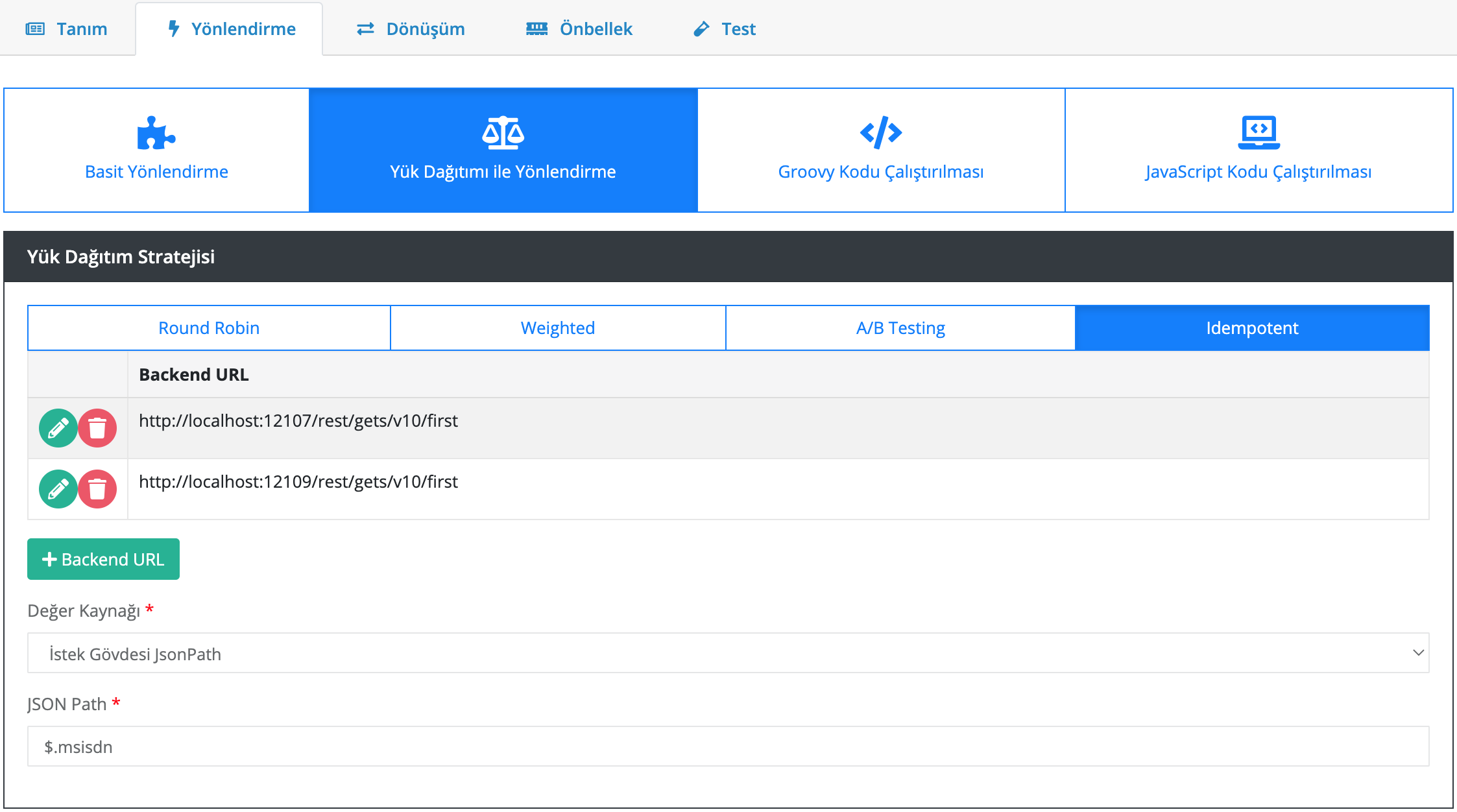 Figure 32. Yönlendirme
Figure 32. YönlendirmeBackend Http Metot GET seçilir.
Kaydet butonuna tıklanır.-
Test
Postman veya benzeri bir REST client üzerinden aşağıdaki gibi bir istek oluşturulur.
Gövde kısmına aşağıdaki json değeri girilir vehttp://localhost:12102/idempotentURL’ine istek atılır.{ "offerKey": "OFR1234", "msisdn": "905554443322" }Atılan istek backend’lerden herhangi birine yönlenebilir. Msisdn değeri değişmediği sürece isteklerin her zaman aynı backend’e yönlendiği görülür.
-
-
Değer kaynağının İstek Gövdesi XPath seçildiği durum:
-
API Oluşturma
Uygulamaya giriş yapılır.
Sol menüden Katalog altında bulunan API'ye tıklanır.
Yeni API Oluştur butonuna tıklanır.
Tanım sekmesinde aşağıdaki bilgiler doldurulur:Ad: Idempotent Load Balancing
Açıklama: Idempotent Load Balancing
Durum: Aktif
Tip: SOAP
EndPoint:/idempotent
Metot: getGenres
Asenkron mu?: Hayır Figure 33. API Oluşturma
Figure 33. API OluşturmaAşağıdaki bilgiler doldurulur:
Backend URL:
http://localhost:12107/soap/posts/v10/firstBackend URL:
http://localhost:12109/soap/posts/v10/firstDeğer Kaynağı: İstek Gövdesi XPath
XPath:Envelope/Body/getGenres/username[text()]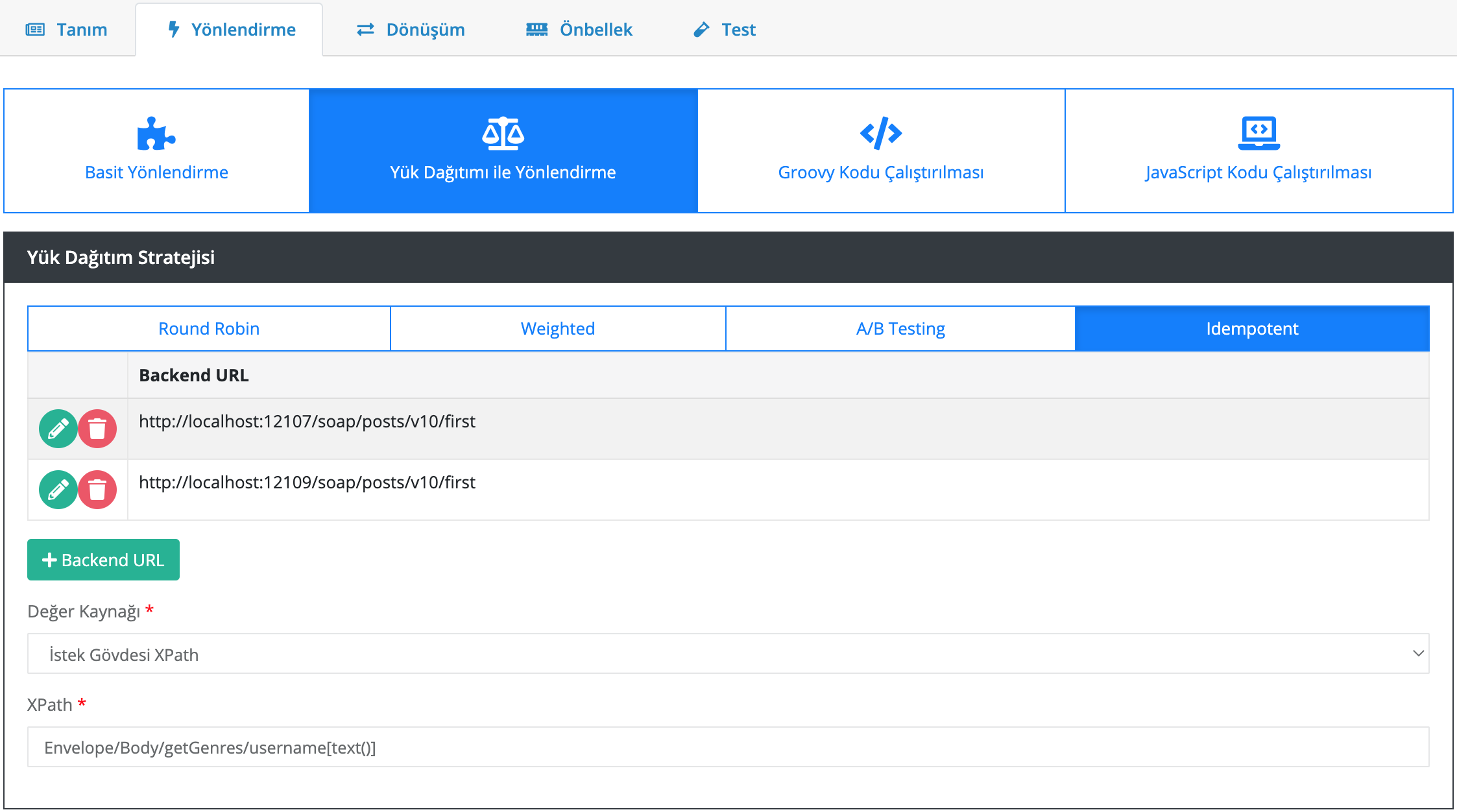 Figure 34. Yönlendirme
Figure 34. YönlendirmeBackend Http Metot POST seçilir.
Kaydet butonuna tıklanır.-
Test
SoapUI veya benzeri bir SOAP Client üzerinden
http://localhost:12102/idempotentURL’ine aşağıdaki istek atılır:<soapenv:Envelope xmlns:soapenv="http://schemas.xmlsoap.org/soap/envelope/" xmlns:wsdl="http://ttmuzikfuncs.proarge.com/wsdl/"> <soapenv:Header/> <soapenv:Body> <wsdl:getGenres> <username>mirket</username> <password>mirket123!</password> <!--Optional:--> <cdata>1</cdata> </wsdl:getGenres> </soapenv:Body> </soapenv:Envelope>Atılan istek backend’lerden herhangi birine yönlenebilir. username değeri değişmediği sürece isteklerin her zaman aynı backend’e yönlendiği görülür.
-
-
Değer kaynağının İş Nesnesi Alanı seçildiği durum:
Katalog → API Kullanıcıları ekranında tanımlı,
IDdeğeri451fa26738a04a39b95e79fcaf6c6fa2,apiKeydeğerif5a66a64-6e7c-4041-84e7-4d62e96fb7dcolan bir kullanıcı olduğu varsayılıyor. Figure 35. Kimlik Doğrulama Yöntemine Sahip API Kullanıcısı
Figure 35. Kimlik Doğrulama Yöntemine Sahip API KullanıcısıAşağıdaki bilgiler doldurulur:
Backend URL:
http://localhost:12107/rest/gets/v10/firstBackend URL:
http://localhost:12109/rest/gets/v10/firstDeğer Kaynağı: İş Nesnesi Alanı
İş Nesnesi Özelliği:API Kullanıcı Id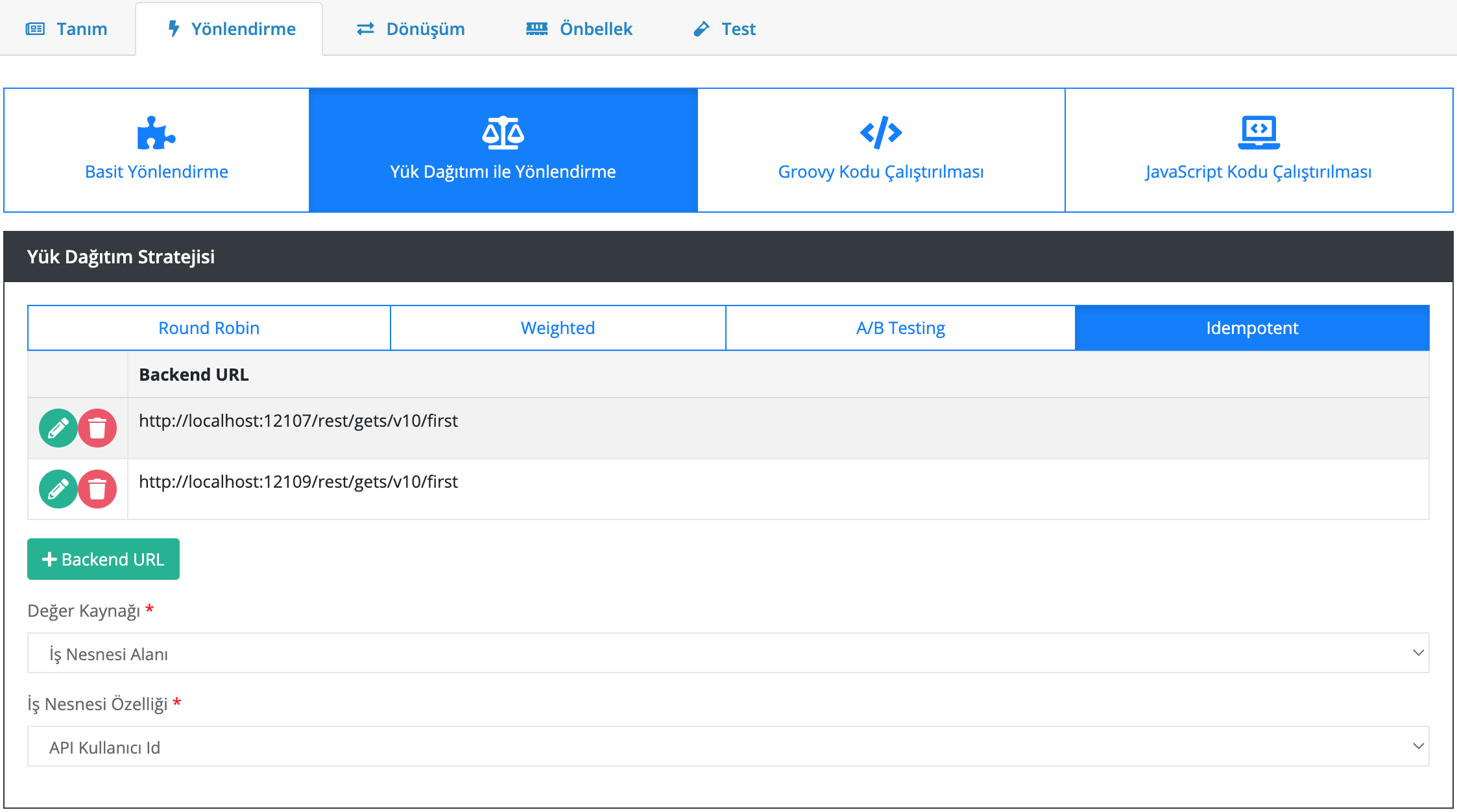 Figure 36. Yönlendirme
Figure 36. YönlendirmeBackend Http Metot GET seçilir.
Kaydet butonuna tıklanır.-
Test
Postman veya benzeri bir REST client üzerinden
http://localhost:12102/idempotent?apiKey=f5a66a64-6e7c-4041-84e7-4d62e96fb7dcURL’ine istek atılır.
Atılan istek backend’lerden herhangi birine yönlenebilir. apiKey değeri değişmediği sürece isteklerin her zaman aynı backend’e yönlendiği görülür. -
-
Değer kaynağının İş Nesnesi Özelliği seçildiği durum:
Sol menüden Katalog → Katalog Ayarları altında bulunan Özellik Tanımları'na tıklanır.
Özellik Tanımı Oluştur butonuna tıklanır.
Aşağıdaki bilgiler doldurulur:Ad: aggregatorId
Nesne Türü: API Kullanıcısı
Veri Giriş Türü: Tek Satırlı Metin Alanı
Veri Tipi: Metin
Varsayılan Değer: 11
Zorunlu Alan mı?: Hayır
Maksimum Uzunluk: Boş
Düzenli İfade: Boş
Görünüm Sırası: 1 Figure 37. Özellik Tanımı Oluşturma
Figure 37. Özellik Tanımı OluşturmaKaydet butonuna tıklanır.
Sol menüden Katalog altında bulunan API Kullanıcıları'na tıklanır.
apiKey değerif5a66a64-6e7c-4041-84e7-4d62e96fb7dcolan API Kullanıcısının güncelle butonuna tıklanır.
Özellikler sekmesinde bulunanaggregatorIdalanına8değeri girilir.
Güncelle butonuna tıklanır.API oluştururken aşağıdaki bilgiler doldurulur:
Backend URL:
http://localhost:12107/rest/gets/v10/firstBackend URL:
http://localhost:12109/rest/gets/v10/firstDeğer Kaynağı: İş Nesnesi Özelliği
Nesne Türü:API Kullanıcısı
Özellik:aggregatorId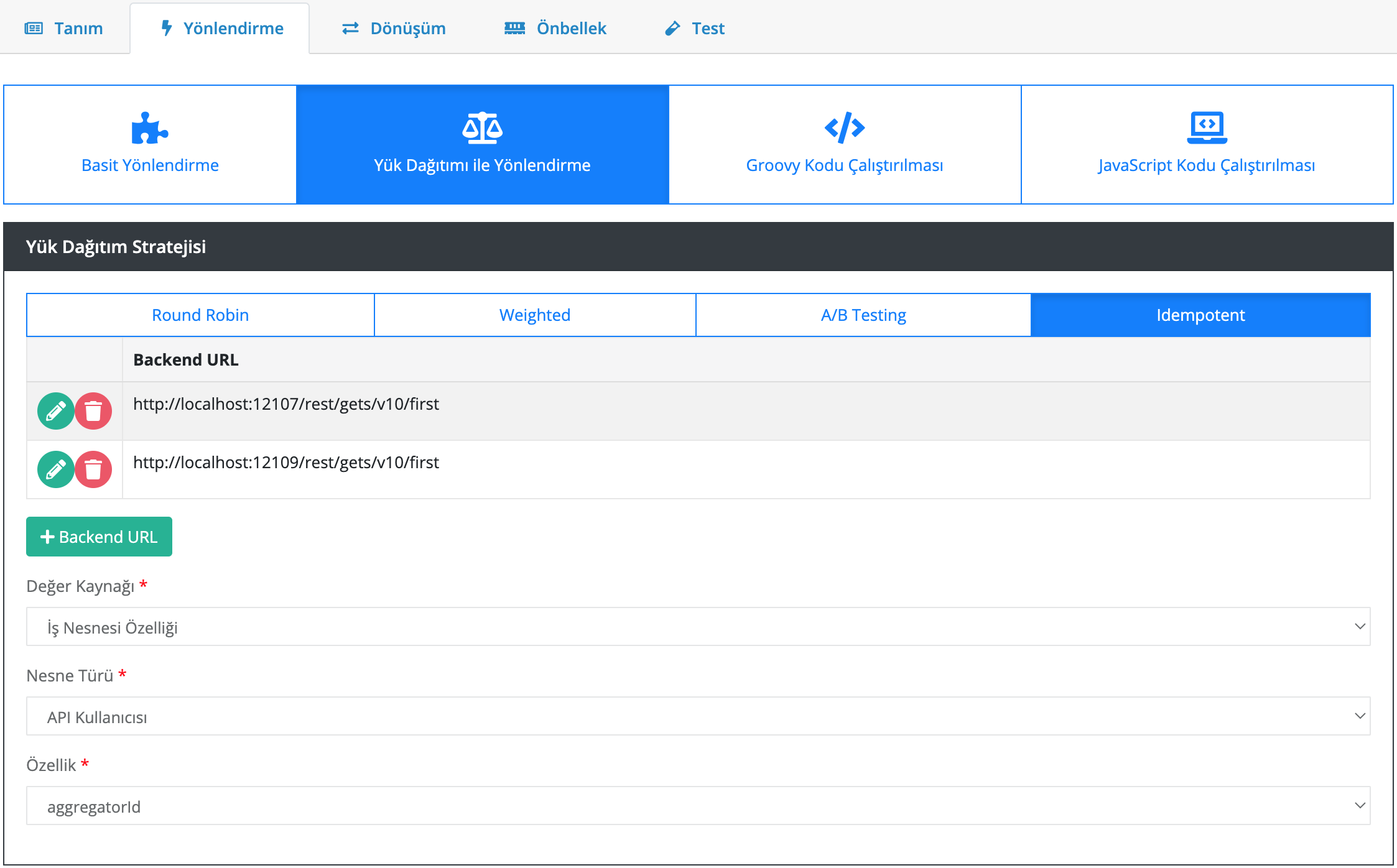 Figure 38. Yönlendirme
Figure 38. YönlendirmeBackend Http Metot GET seçilir.
Kaydet butonuna tıklanır.-
Test
Postman veya benzeri bir REST client üzerinden
http://localhost:12102/idempotent?apiKey=f5a66a64-6e7c-4041-84e7-4d62e96fb7dcURL’ine istek atılır.
Atılan istek backend’lerden herhangi birine yönlenebilir. apiKey değeri değişmediği sürece isteklerin her zaman aynı backend’e yönlendiği görülür. -
Groovy Kod Routing – External REST API
Aşağıdaki kod ile API üzerinde dinamik olarak yazılan id değeri alınıyor.
https://jsonplaceholder.typicode.com/posts sitesine get isteği atılıyor.
Dönen sonuç ve id değeri body üzerine ekleniyor.
package com.mirket.gateway.groovy;
import jakarta.servlet.http.HttpServletRequest;
import java.util.HashMap;
import java.util.Map;
import org.slf4j.Logger
import org.slf4j.LoggerFactory
import groovy.json.JsonSlurper
import org.apache.http.HttpResponse
import org.apache.http.client.HttpClient
import org.apache.http.client.methods.HttpGet
import org.apache.http.impl.client.HttpClients
import org.springframework.web.util.UriTemplate
import java.util.List
import java.util.Map
public class GroovyRouteScriptImpl implements GroovyRouteScript {
private static final Logger LOG = LoggerFactory.getLogger('GroovyLogger')
public void execute(HttpServletRequest request, RoutingContext context) {
int statusCode = 200;
context.setStatusCode(statusCode);
HttpClient httpclient = HttpClients.createDefault() as HttpClient;
HttpGet httpget = new HttpGet("https://jsonplaceholder.typicode.com/posts");
HttpResponse response = null
StringBuilder result = null
try {
response = httpclient.execute(httpget);
InputStream ins = response.getEntity().getContent();
BufferedReader reader = new BufferedReader(new InputStreamReader(ins));
result = new StringBuilder();
String line = new String();
while ((line = reader.readLine()) != null) {
result.append(line);
}
def id = readPathParameter(request);
String responseBody = "{\"status\": \"POST_NOT_FOUND\", \"id\": \"" + id + "\"}"
JsonSlurper jsonSlurper = new JsonSlurper()
List<Map<String, Object>> json = jsonSlurper.parseText(result.toString()) as List<Map<String, Object>>
json.forEach(map -> {
def idAsString = String.valueOf(map.get("id"));
if (idAsString.equals(id)) {
responseBody = "{\"status\": \"OK\", \"id\": \"" + id + "\", \"title\": \"" + map.get("title") + "\"}"
}
})
context.setResponseBody(responseBody);
} catch (IOException e) {
LOG.error("Hata Oldu");
}
}
private String readPathParameter(HttpServletRequest request) {
return new UriTemplate("/groovy/posts/{id}/title")
.match(request.getRequestURI())
.get("id");
}
}Groovy Kod Routing – External SOAP API
Aşağıdaki kod ile API üzerinde dinamik olarak yazılan sayısal değer alınıyor.
https://www.dataaccess.com/webservicesserver/NumberConversion.wso sitesine soap isteği atılıyor.
Gelen sayısal değer soap body parametresi olarak kullanılıyor.
Dönen soap sonucu parse edilip json formatında dönülüyor.
package com.mirket.gateway.groovy
import groovy.xml.XmlSlurper
import org.apache.http.client.methods.HttpPost
import org.apache.http.entity.StringEntity
import jakarta.servlet.http.HttpServletRequest;
import java.util.HashMap;
import java.util.Map;
import org.slf4j.Logger
import org.slf4j.LoggerFactory
import groovy.json.JsonSlurper
import org.apache.http.HttpResponse
import org.apache.http.client.HttpClient
import org.apache.http.client.methods.HttpGet
import org.apache.http.impl.client.HttpClients
import org.springframework.web.util.UriTemplate
import java.util.List
import java.util.Map
class GroovyRouteScriptImpl implements GroovyRouteScript {
private static final Logger LOG = LoggerFactory.getLogger('GroovyLogger')
void execute(HttpServletRequest request, RoutingContext context) {
int statusCode = 200;
context.setStatusCode(statusCode);
def numParam = readPathParameter(request)
String soapBody = "<soap:Envelope xmlns:soap=\"http://schemas.xmlsoap.org/soap/envelope/\">\n" +
" <soap:Body>\n" +
" <NumberToDollars xmlns=\"http://www.dataaccess.com/webservicesserver/\">\n" +
" <dNum>${numParam}</dNum>\n" +
" </NumberToDollars>\n" +
" </soap:Body>\n" +
"</soap:Envelope>";
HttpClient httpClient = HttpClients.createDefault() as HttpClient;
StringEntity stringEntity = new StringEntity(soapBody, "text/xml", "UTF-8")
HttpPost httpPost = new HttpPost("https://www.dataaccess.com/webservicesserver/NumberConversion.wso");
httpPost.setEntity(stringEntity);
HttpResponse response = null
StringBuilder result = null
try {
response = httpClient.execute(httpPost);
InputStream ins = response.getEntity().getContent();
BufferedReader reader = new BufferedReader(new InputStreamReader(ins));
result = new StringBuilder();
String line = new String();
while ((line = reader.readLine()) != null) {
result.append(line);
}
def resultAsString = result.toString();
def slurper = new XmlSlurper()
def dollarsResult = slurper.parseText(resultAsString).toString();
String responseBody = "{\"result\": \"${dollarsResult}\"}"
context.setResponseBody(responseBody);
} catch (IOException e) {
LOG.error("Hata Oldu");
}
}
private String readPathParameter(HttpServletRequest request) {
return new UriTemplate("/dollars/{num}/text")
.match(request.getRequestURI())
.get("num");
}
}Groovy Kod Routing – Database Access - ORACLE
Aşağıdaki kod ile API üzerinde dinamik olarak yazılan id değeri alınıyor.
Veri kaynaklarında tanımlı <ORACLE-DATASOURCE-ALIAS> takma adına sahip olan veri kaynağındaki CUSTOMERS tablosundan ilgili id değerine sahip olan veriler çekilir.
Json formatında dönülür.
package com.mirket.gateway.groovy
import jakarta.servlet.http.HttpServletRequest
import java.util.HashMap
import com.mirket.datasources.DataSourceFactory
import org.springframework.beans.factory.annotation.Autowired
import org.springframework.jdbc.core.RowMapper
import java.lang.Object
import java.lang.Override
import java.sql.ResultSet
import java.sql.SQLException
import java.io.Serializable
import org.json.JSONObject
import groovy.json.JsonOutput
public class GroovyRouteScriptImpl implements GroovyRouteScript {
@Autowired
private final DataSourceFactory dataSourceFactory;
public void execute(HttpServletRequest request, RoutingContext context) {
Map<String, String> responseHeaders = new HashMap<>()
String responseBody = "{\"status\": \"OK\"}"
int statusCode = 200
context.setStatusCode(statusCode)
def msisdn = request.getParameter('msisdn')
def customer = this.findByCustomerIdOracle(msisdn)
def json = JsonOutput.toJson(customer)
context.setResponseBody(json)
context.setResponseHeaders(responseHeaders)
}
def findByCustomerIdOracle(id) {
def jdbcTemplate = dataSourceFactory.getOrCreateJdbcTemplate('<ORACLE-DATASOURCE-ALIAS>')
try {
return jdbcTemplate.queryForObject("SELECT * FROM CUSTOMERS WHERE MSISDN = ?", new CustomerMapper() , id
)
} catch (e) {
println('Hata Oldu: {}' + e)
return { id: -1 };
}
}
class Customer implements Serializable {
Long id;
String status;
String linetype;
public Customer( Long id, String status, String linetype){
this.id = id;
this.status = status;
this.linetype = linetype;
}
}
class CustomerMapper implements RowMapper<Customer> {
@Override
public Customer mapRow(ResultSet rs, int rowNum) throws SQLException {
return new Customer(rs.getLong("MSISDN"), rs.getString("STATUS"), rs.getString("LINETYPE"));
}
}
}Groovy Kod Routing – Database Access - MYSQL
Aşağıdaki kod ile API üzerinde dinamik olarak yazılan id değeri alınıyor.
Veri kaynaklarında tanımlı <MYSQL-DATASOURCE-ALIAS> takma adına sahip olan veri kaynağındaki CUSTOMERS tablosundan ilgili id değerine sahip olan veriler çekilir.
Json formatında dönülür.
package com.mirket.gateway.groovy
import jakarta.servlet.http.HttpServletRequest
import java.util.HashMap
import com.mirket.datasources.DataSourceFactory
import org.springframework.beans.factory.annotation.Autowired
import org.springframework.jdbc.core.RowMapper
import java.lang.Object
import java.lang.Override
import java.sql.ResultSet
import java.sql.SQLException
import java.io.Serializable
import org.json.JSONObject
import groovy.json.JsonOutput
public class GroovyRouteScriptImpl implements GroovyRouteScript {
@Autowired
private final DataSourceFactory dataSourceFactory
public void execute(HttpServletRequest request, RoutingContext context) {
Map<String, String> responseHeaders = new HashMap<>()
String responseBody = "{\"status\": \"OK\"}"
int statusCode = 200
context.setStatusCode(statusCode)
def msisdn = request.getParameter('msisdn')
def customer = this.findByCustomerIdOracle(msisdn)
def json = JsonOutput.toJson(customer)
context.setResponseBody(json)
context.setResponseHeaders(responseHeaders)
}
def findByCustomerIdOracle(id) {
def jdbcTemplate = dataSourceFactory.getOrCreateJdbcTemplate('<MYSQL-DATASOURCE-ALIAS>')
try {
return jdbcTemplate.queryForObject('SELECT * FROM CUSTOMERS WHERE MSISDN = ?', new CustomerMapper() , id
)
} catch (e) {
println('Hata Oldu: {}' + e)
return { id: -1 };
}
}
class Customer implements Serializable {
Long id
String status
String linetype
public Customer( Long id, String status, String linetype) {
this.id = id
this.status = status
this.linetype = linetype
}
}
class CustomerMapper implements RowMapper<Customer> {
@Override
public Customer mapRow(ResultSet rs, int rowNum) throws SQLException {
return new Customer(rs.getLong('MSISDN'), rs.getString('STATUS'), rs.getString('LINETYPE'))
}
}
}Groovy Kod Routing – Database Access - MONGO DB
Aşağıdaki kod ile API üzerinde dinamik olarak yazılan id değeri alınıyor.
Veri kaynaklarında tanımlı <MONGODB-DATASOURCE-ALIAS> takma adına sahip olan veri kaynağındaki CUSTOMERS tablosundan ilgili id değerine sahip olan veriler çekilir.
Json formatında dönülür.
package com.mirket.gateway.groovy
import jakarta.servlet.http.HttpServletRequest
import java.util.HashMap
import com.mirket.datasources.DataSourceFactory
import org.springframework.beans.factory.annotation.Autowired
import org.springframework.jdbc.core.RowMapper
import java.lang.Object
import java.lang.Override
import java.sql.ResultSet
import java.sql.SQLException
import java.io.Serializable
import org.json.JSONObject
import groovy.json.JsonOutput
import com.mongodb.client.model.Filters
public class GroovyRouteScriptImpl implements GroovyRouteScript {
@Autowired
private final DataSourceFactory dataSourceFactory
public void execute(HttpServletRequest request, RoutingContext context) {
Map<String, String> responseHeaders = new HashMap<>()
String responseBody = "{\"status\": \"OK\"}"
int statusCode = 200
context.setStatusCode(statusCode)
def msisdn = request.getParameter('msisdn')
def customer = this.findByCustomerIdMongo(msisdn)
def json = JsonOutput.toJson(customer)
context.setResponseBody(json)
context.setResponseHeaders(responseHeaders)
}
def findByCustomerIdMongo(id) {
try {
def mongoDatabase = dataSourceFactory.getOrCreteMongoDatabase('<MONGODB-DATASOURCE-ALIAS>', 'mirketJanissary')
return mongoDatabase.getCollection('customers').find(Filters.eq('_id', id)).first()
} catch (e) {
println('Hata Oldu: {}' + e)
return { id: -1 };
}
}
class Customer implements Serializable {
Long id
String status
String linetype
public Customer( Long id, String status, String linetype) {
this.id = id
this.status = status
this.linetype = linetype
}
}
}Groovy Request Response Dönüşümü - Rest to Soap
Aşağıdaki groovy kodları ile gelen istekteki json body soap xml’e çevrilir.
Sonuç olarak gelen soap xml ise json’a çevrilir.
package com.mirket.gateway.groovy;
import groovy.json.JsonSlurper
public class GroovyTransformationScriptImpl implements GroovyTransformationScript {
public byte[] transform(byte[] json) {
def jsonSlurper = new JsonSlurper()
def object = jsonSlurper.parseText(new String(json))
String username = object.getAt("username")
String password = object.getAt("password")
return ("<soapenv:Envelope xmlns:soapenv=\"http://schemas.xmlsoap.org/soap/envelope/\" xmlns:wsdl=\"http://ttmuzikfuncs.proarge.com/wsdl/\">\n" +
" <soapenv:Header/>\n" +
" <soapenv:Body>\n" +
" <wsdl:getBannerList>\n" +
" <username>${username}</username>\n" +
" <password>${password}</password>\n" +
" </wsdl:getBannerList>\n" +
" </soapenv:Body>\n" +
" </soapenv:Envelope>").getBytes()
}
}Dönüş tipi olan Banner için bir sınıf tanımlanarak dönülen değerl map edilmiştir.
package com.mirket.gateway.groovy;
import groovy.json.JsonOutput
import java.util.regex.Pattern
public class GroovyTransformationScriptImpl implements GroovyTransformationScript {
public byte[] transform(byte[] input) {
def idPattern = Pattern.compile("<id>(.*?)</id>");
def contentIdPattern = Pattern.compile("<contentId>(.*?)</contentId>");
def contentTypePattern = Pattern.compile("<image>(.*?)</image>");
def imagePattern = Pattern.compile("<image>(.*?)</image>");
def redirectUrlPattern = Pattern.compile("<redirectURL>(.*?)</redirectURL>");
def isFavoritePattern = Pattern.compile("<isFavorite>(.*?)</isFavorite>");
def inputAsString = new String(input)
def ids = getValuesByPattern(inputAsString, idPattern);
def contentIds = getValuesByPattern(inputAsString, contentIdPattern);
def contentTypes = getValuesByPattern(inputAsString, contentTypePattern);
def imagePatterns = getValuesByPattern(inputAsString, imagePattern);
def redirectUrls = getValuesByPattern(inputAsString, redirectUrlPattern);
def isFavorites = getValuesByPattern(inputAsString, isFavoritePattern);
def banners = []
for (def i = 0; i < ids.size(); i++) {
def banner = new Banner(id: ids[i], contentId: contentIds[i], contentType: contentTypes[i], image: imagePatterns[i], redirectURL: redirectUrls[i], isFavorite: isFavorites[i])
banners.push(banner)
}
def output = JsonOutput.toJson(banners:banners)
return output.getBytes();
}
public static List<Object> getValuesByPattern(String input, Pattern pattern) {
def values = [];
def matcher = pattern.matcher(input);
while (matcher.find()) {
def value = matcher.group(1);
values.push(value);
}
return values;
}
}
class Banner {
String id
String contentId
String contentType
String image
String redirectURL
boolean isFavorite;
}Groovy Request Response Dönüşümü - Soap to Rest
Aşağıdaki groovy kodları ile gelen istekteki soap xml body soap json formatına çevrilir.
Sonuç olarak gelen json body ise soap xml formatına çevrilir.
package com.mirket.gateway.groovy;
import java.nio.charset.StandardCharsets
import java.util.regex.Pattern
public class GroovyTransformationScriptImpl implements GroovyTransformationScript {
public byte[] transform(byte[] input) {
def inputString = new String(input, StandardCharsets.UTF_8)
def userId = parse("userId", inputString)
def id = parse("id", inputString)
def title = parse("title", inputString)
def body = parse("body", inputString)
def json = generateJson(userId, id, title, body)
return json.getBytes(StandardCharsets.UTF_8)
}
static String parse(String tagName, String input) {
def matcher = Pattern.compile("<$tagName>(.*?)
</$tagName>").matcher(input)
return matcher.find() ? matcher.group(1) : ""
}
static String generateJson(String userId, String id, String title, String body) {
return "{\"userId\": ${userId}, \"id\": ${id}, \"title\":
\"${title}\", \"body\": \"${body}\"}"
}
}package com.mirket.gateway.groovy;
import groovy.json.JsonSlurper
import java.nio.charset.StandardCharsets
public class GroovyTransformationScriptImpl implements GroovyTransformationScript {
public byte[] transform(byte[] input) {
def inputString = new String(input, StandardCharsets.UTF_8)
def response = parseJson(inputString)
return response.getBytes(StandardCharsets.UTF_8)
}
static String parseJson(String input) {
JsonSlurper jsonSlurper = new JsonSlurper()
Map<String, Object> json = jsonSlurper.parseText(input) as Map<String, Object>
return generateSoap(json)
}
static String generateSoap(Map<String, Object> map) {
return "<soapenv:Envelope
xmlns:soapenv=\"http://schemas.xmlsoap.org/soap/envelope/\"
xmlns:wsdl=\"http://jsonplaceholder.com/wsdl/\">\n" +
" <soapenv:Header/>\n" +
" <soapenv:Body>\n" +
" <wsdl:updatePostResponse>\n" +
" <userId>${map.get("userId")}</userId>\n" +
" <id>${map.get("id")}</id>\n" +
" <title>${map.get("title")}</title>\n" +
" <body>${map.get("body")}</body>\n" +
" </wsdl:updatePostResponse>\n" +
" </soapenv:Body>\n" +
"</soapenv:Envelope>"
}
}Javascript Kod Routing – External REST API
Aşağıdaki kod ile API üzerinde dinamik olarak yazılan id değeri alınıyor.
https://jsonplaceholder.typicode.com/posts sitesine get isteği atılıyor.
Dönen sonuç ve id değeri body üzerine ekleniyor.
const UriTemplate = Java.type('org.springframework.web.util.UriTemplate');
const IOUtils = Java.type('org.apache.commons.io.IOUtils');
const HttpResponse = Java.type('org.apache.http.client.methods.CloseableHttpResponse');
const HttpGet = Java.type('org.apache.http.client.methods.HttpGet');
const HttpClients = Java.type('org.apache.http.impl.client.HttpClients');
function execute(request, context) {
var httpClient = HttpClients.createDefault();
var serviceUrl = "https://jsonplaceholder.typicode.com/posts";
var httpGet = new HttpGet(serviceUrl);
httpGet.addHeader("Content-Type", "application/json; charset=utf-8");
var httpResponse = httpClient.execute(httpGet);
var entity = httpResponse.getEntity();
var responseAsString = IOUtils.toString(entity.getContent());
const responseAsJson = JSON.parse(responseAsString);
const id = readPathVariable(request);
const posts = responseAsJson.filter(function (element) {
return element.id == id;
});
if (posts.length > 0) {
delete posts[0].userId;
delete posts[0].body;
posts[0].status = 'OK';
context.statusCode = 200;
context.responseBody = JSON.stringify(posts[0]);
} else {
context.statusCode = 400;
context.responseBody = getErrorResponse('POST_NOT_FOUND', id);
}
context.responseHeaders = {"content-type": "application/json"};
}
function readPathVariable(request) {
return new UriTemplate("/posts/{id}/title")
.match(request.getRequestURI())
.get("id");
}
function getErrorResponse(status, id) {
return `{ "status": "${status}", "id": "${id}" }`;
}Javascript Kod Routing – External SOAP API
Aşağıdaki kod ile API üzerinde dinamik olarak yazılan sayısal değer alınıyor.
https://www.dataaccess.com/webservicesserver/NumberConversion.wso sitesine soap isteği atılıyor.
Gelen sayısal değer soap body parametresi olarak kullanılıyor.
Dönen soap sonucu parse edilip json formatında dönülüyor.
const UriTemplate = Java.type('org.springframework.web.util.UriTemplate');
const IOUtils = Java.type('org.apache.commons.io.IOUtils');
const EntityUtils = Java.type('org.apache.http.util.EntityUtils');
const HttpResponse = Java.type('org.apache.http.client.methods.CloseableHttpResponse');
const HttpPost = Java.type('org.apache.http.client.methods.HttpPost');
const HttpClients = Java.type('org.apache.http.impl.client.HttpClients');
const StringEntity = Java.type('org.apache.http.entity.StringEntity');
const Pattern = Java.type('java.util.regex.Pattern');
const ExceptionUtils = Java.type('org.apache.commons.lang3.exception.ExceptionUtils');
const NumberUtils = {
isNumeric: function(str) {
if (typeof str != "string") {
return false;
}
return !isNaN(str) && !isNaN(parseFloat(str));
}
}
function execute(request, context) {
context.statusCode = 200;
context.responseBody = doExecute(request);
context.responseHeaders = {"content-type": "application/json"};
}
function doExecute(request) {
const dollarNumber = readDollarNumber(request);
validateRequest(dollarNumber);
const httpClient = HttpClients.createDefault();
let httpResponse = null;
let entity = null;
try {
const serviceURL = "https://www.dataaccess.com/webservicesserver/NumberConversion.wso";
const httpPost = new HttpPost(serviceURL);
httpPost.addHeader("Content-Type", "text/xml; charset=utf-8");
const requestBody = `<?xml version="1.0" encoding="utf-8"?>
<soap:Envelope xmlns:soap="http://schemas.xmlsoap.org/soap/envelope/">
<soap:Body>
<NumberToDollars xmlns="http://www.dataaccess.com/webservicesserver/">
<dNum>${dollarNumber}</dNum>
</NumberToDollars>
</soap:Body>
</soap:Envelope>`;
httpPost.setEntity(new StringEntity(requestBody, "text/xml", "utf-8"));
httpResponse = httpClient.execute(httpPost);
entity = httpResponse.getEntity();
return processResponse(entity);
} catch (e) {
throw e;
} finally {
EntityUtils.consumeQuietly(entity);
IOUtils.closeQuietly(httpResponse);
httpClient.close();
}
}
function readDollarNumber(request) {
return new UriTemplate("/dollars/{num}/text")
.match(request.getRequestURI())
.get("num");
}
function processResponse(entity) {
const responseAsString = IOUtils.toString(entity.getContent());
const result = parseNumberToDollarsResult(responseAsString);
return `{ "result": "${result}" }`;
}
function parseNumberToDollarsResult(response) {
const matcher = Pattern.compile("<m:NumberToDollarsResult>(.*?)</m:NumberToDollarsResult>")
.matcher(response);
return matcher.find() ? matcher.group(1) : "";
}
function validateRequest(dollarNumber) {
if (!NumberUtils.isNumeric(dollarNumber)) {
throw `num is not number: ${dollarNumber}`;
}
}Javascript Kod Routing – Database Access - ORACLE
Aşağıdaki kod ile API üzerinde dinamik olarak yazılan id değeri alınıyor.
Veri kaynaklarında tanımlı ORACLEDB_ALIAS takma adına sahip olan veri kaynağındaki CUSTOMERS tablosundan ilgili id değerine sahip olan veriler çekilir.
Json formatında dönülür.
const IntArray = Java.type("int[]");
const ObjectArray = Java.type('java.lang.Object[]');
const ArrayList = Java.type('java.util.ArrayList');
const HashMap = Java.type('java.util.HashMap');
const RowMapper = Java.type('org.springframework.jdbc.core.RowMapper');
const Filters = Java.type('com.mongodb.client.model.Filters');
const Constants = {
MONGODB_ALIAS: 'mymongo',
ORACLEDB_ALIAS: 'prodoracledbv1',
MYSQLDB_ALIAS: 'mysqltest',
CASSANDRADB_ALIAS: 'cassv13',
GET_MVNO_BY_ID_SQL: 'db.customers.find({"_id": "?"})'
};
function findByCustomerIdOracle(id) {
const rowMapper = new RowMapper({
mapRow: convertToCustomer
});
const jdbcTemplate = getJdbcTemplate();
try {
return jdbcTemplate.queryForObject(Constants.GET_MVNO_BY_ID_MYSQL, rowMapper, id);
} catch(e) {
print('Hata Oldu: {}' + e);
return {id: -1};
}
}
function getJdbcTemplate() {
return dataSourceFactory.getOrCreateJdbcTemplate(Constants.ORACLEDB_ALIAS);
}
function convertToCustomer(rs, rowNum) {
var customer = {};
customer.id = rs.getString('id');
customer.status = rs.getString('status');
customer.lineType = rs.getString('lineType');
return customer;
}Javascript Kod Routing – Database Access - MYSQL
Aşağıdaki kod ile API üzerinde dinamik olarak yazılan id değeri alınıyor.
Veri kaynaklarında tanımlı Constants.MYSQLDB_ALIAS takma adına sahip olan veri kaynağındaki CUSTOMERS tablosundan ilgili id değerine sahip olan veriler çekilir.
Json formatında dönülür.
const IntArray = Java.type("int[]");
const ObjectArray = Java.type('java.lang.Object[]');
const ArrayList = Java.type('java.util.ArrayList');
const HashMap = Java.type('java.util.HashMap');
const RowMapper = Java.type('org.springframework.jdbc.core.RowMapper');
const Filters = Java.type('com.mongodb.client.model.Filters');
const Constants = {
MONGODB_ALIAS: 'mymongo',
ORACLEDB_ALIAS: 'prodoracledbv1',
MYSQLDB_ALIAS: 'mysqltest',
CASSANDRADB_ALIAS: 'cassv13',
GET_MVNO_BY_ID_SQL: 'db.customers.find({"_id": "?"})'
};
function findByCustomerIdMysql(id) {
const rowMapper = new RowMapper({
mapRow: convertToCustomer
});
const jdbcTemplate = getJdbcTemplate();
try {
return jdbcTemplate.queryForObject(Constants.GET_MVNO_BY_ID_MYSQL, rowMapper, id);
} catch(e) {
print('Hata Oldu: {}' + e);
return {id: -1};
}
}
function getJdbcTemplate() {
return dataSourceFactory.getOrCreateJdbcTemplate(Constants.MYSQLDB_ALIAS);
}
function convertToCustomer(rs, rowNum) {
var customer = {};
customer.id = rs.getString('id');
customer.status = rs.getString('status');
customer.lineType = rs.getString('lineType');
return customer;
}Javascript Kod Routing – Database Access - MONGO DB
Aşağıdaki kod ile API üzerinde dinamik olarak yazılan id değeri alınıyor.
Veri kaynaklarında tanımlı Constants.MONGODB_ALIAS takma adına sahip olan veri kaynağındaki CUSTOMERS tablosundan ilgili id değerine sahip olan veriler çekilir.
Json formatında dönülür.
const IntArray = Java.type("int[]");
const ObjectArray = Java.type('java.lang.Object[]');
const ArrayList = Java.type('java.util.ArrayList');
const HashMap = Java.type('java.util.HashMap');
const RowMapper = Java.type('org.springframework.jdbc.core.RowMapper');
const Filters = Java.type('com.mongodb.client.model.Filters');
const Constants = {
MONGODB_ALIAS: 'mymongo',
ORACLEDB_ALIAS: 'prodoracledbv1',
MYSQLDB_ALIAS: 'mysqltest',
CASSANDRADB_ALIAS: 'cassv13',
GET_MVNO_BY_ID_SQL: 'db.customers.find({"_id": "?"})'
};
function findByCustomerId(id) {
const rowMapper = new RowMapper({
mapRow: convertToCustomer
});
try {
var customerDocument = getCollection().find(Filters.eq("_id", id)).first();
return convertToCustomer(customerDocument);
} catch(e) {
print('Hata Oldu: {}' + e);
return {id: -1};
}
}
function getCollection() {
const mongoDatabase = dataSourceFactory.getOrCreteMongoDatabase(Constants.MONGODB_ALIAS, "mirketJanissary");
return mongoDatabase.getCollection("customers");
}
function convertToCustomer(customerDocument) {
var customer = {};
customer.id = customerDocument.get('_id');
customer.status = customerDocument.get('status');
customer.lineType = customerDocument.get('lineType');
return customer;
}Javascript Kod Routing – Database Access - POSTGRES
Aşağıdaki kod ile API üzerinde dinamik olarak yazılan id değeri alınıyor.
Veri kaynaklarında tanımlı Constants.POSTGRESDB_ALIAS takma adına sahip olan veri kaynağındaki CUSTOMERS tablosundan ilgili id değerine sahip olan veriler çekilir.
Json formatında dönülür.
const IntArray = Java.type("int[]");
const ObjectArray = Java.type('java.lang.Object[]');
const ArrayList = Java.type('java.util.ArrayList');
const HashMap = Java.type('java.util.HashMap');
const RowMapper = Java.type('org.springframework.jdbc.core.RowMapper');
const Filters = Java.type('com.mongodb.client.model.Filters');
const Constants = {
MONGODB_ALIAS: 'mymongo',
ORACLEDB_ALIAS: 'prodoracledbv1',
MYSQLDB_ALIAS: 'mysqltest',
CASSANDRADB_ALIAS: 'cassv13',
POSTGRESDB_ALIAS: 'postgresv2',
GET_MVNO_BY_ID_SQL: 'db.customers.find({"_id": "?"})'
};
function findByCustomerIdPostgres(id) {
const rowMapper = new RowMapper({
mapRow: convertToCustomer
});
const jdbcTemplate = getJdbcTemplate();
try {
return jdbcTemplate.queryForObject(Constants.GET_MVNO_BY_ID_MYSQL, rowMapper, id);
} catch(e) {
print('Hata Oldu: {}' + e);
return {id: -1};
}
}
function getJdbcTemplate() {
return dataSourceFactory.getOrCreateJdbcTemplate(Constants.POSTGRESDB_ALIAS);
}
function convertToCustomer(rs, rowNum) {
var customer = {};
customer.id = rs.getString('id');
customer.status = rs.getString('status');
customer.lineType = rs.getString('lineType');
return customer;
}Javascript Request Response Dönüşümü - Rest to Soap
Aşağıdaki javascript kodları ile gelen istekteki json body soap xml’e çevrilir.
Sonuç olarak gelen soap xml ise json’a çevrilir.
Json body üzerinde gelen username ve password soap xml’ine çevrilir.
function transform(input) {
const requestBody = JSON.parse(input);
const username = requestBody.username;
const password = requestBody.password;
return `<soapenv:Envelope xmlns:soapenv="http://schemas.xmlsoap.org/soap/envelope/" xmlns:wsdl="http://ttmuzikfuncs.proarge.com/wsdl/">
<soapenv:Header/>
<soapenv:Body>
<wsdl:getBannerList>
<username>${username}</username>
<password>${password}</password>
</wsdl:getBannerList>
</soapenv:Body>
</soapenv:Envelope>`;
}Dönüş tipi olan Banner için bir nesne olarak listeye eklenir ve json formatında dönülür.
function transform(input) {
const banners = [];
const idPattern = Pattern.compile("<id>(.*?)</id>");
const contentIdPattern = Pattern.compile("<contentId>(.*?)</contentId>");
const contentTypePattern = Pattern.compile("<image>(.*?)</image>");
const redirectUrlPattern = Pattern.compile("<redirectURL>(.*?)</redirectURL>");
const isFavoritePattern = Pattern.compile("<isFavorite>(.*?)</isFavorite>");
const ids = getValuesByPattern(input, idPattern);
const contentIds = getValuesByPattern(input, contentIdPattern);
const contentTypes = getValuesByPattern(input, contentTypePattern);
const redirectUrls = getValuesByPattern(input, redirectUrlPattern);
const isFavorites = getValuesByPattern(input, isFavoritePattern);
for (let i = 0; i < ids.length; i++) {
banners.push(JSON.stringify({
"id": ids[i],
"contentId": contentIds[i],
"contentType": contentTypes[i],
"redirectUrl": redirectUrls[i],
"isFavorite": isFavorites[i]
}));
}
return `{
"banners": [ ${banners} ]
}`;
}
function getValuesByPattern(input, pattern) {
const values = [];
const matcher = pattern.matcher(input);
while (matcher.find()) {
const value = matcher.group(1);
values.push(value);
}
return values;
}Javascript Request Response Dönüşümü - Soap to Rest
Aşağıdaki javascript kodları ile gelen istekteki soap xml body soap json formatına çevrilir.
Sonuç olarak gelen json body ise soap xml formatına çevrilir.
Pattern ve ExceptionUtils sınıflarını kullanabilmek için aşağdaıki tanımlar ortak kodlar üzerinde yapılmalı.
const Pattern = Java.type('java.util.regex.Pattern');
const ExceptionUtils = Java.type('org.apache.commons.lang3.exception.ExceptionUtils');function transform(input) {
var userId = parseUserId(input);
var id = parseId(input);
var title = parseTitle(input);
var body = parseBody(input);
return JSON.stringify({userId, id, title, body});
}
function parseUserId(r) {
const matcher = Pattern.compile("<userId>(.*?)</userId>").matcher(r);
return matcher.find() ? matcher.group(1) : "";
}
function parseId(r) {
const matcher = Pattern.compile("<id>(.*?)</id>").matcher(r);
return matcher.find() ? matcher.group(1) : "";
}
function parseTitle(r) {
const matcher = Pattern.compile("<title>(.*?)</title>").matcher(r);
return matcher.find() ? matcher.group(1) : "";
}
function parseBody(r) {
const matcher = Pattern.compile("<body>(.*?)</body>").matcher(r);
return matcher.find() ? matcher.group(1) : "";
}function transform(input) {
print(input)
const obj = JSON.parse(input);
var userId = obj.userId;
var id = obj.id;
var title = obj.title;
var body = obj.body;
return "<soapenv:Envelope
xmlns:soapenv=\"http://schemas.xmlsoap.org/soap/envelope/\"
xmlns:wsdl=\"http://jsonplaceholder.com/wsdl/\">\n" +
"<soapenv:Header/>\n" +
"<soapenv:Body>\n" +
"<wsdl:updatePostResponse>\n" +
" <userId>" + userId + "</userId>\n" +
" <id>" + id + "</id>\n" +
" <title>" + title + "</title>\n" +
" <body>" + body + "</body>\n" +
" </wsdl:updatePostResponse>\n" +
"</soapenv:Body>\n" +
"</soapenv:Envelope>"
}Freemarker Request Response Dönüşümü - Rest to Soap
Aşağıdaki dönüşüm kodları ile Rest olarak API’ye gelen istek Soap’a çevrilerek iletilir.
Gelen Soap sonucu ise Rest formatına çevrilerek dönülür.
Gelen istekteki json body üzerinde bulunan username ve password değerleri aşağıdaki kod ile soap xml’i üzerine verilir.
<soapenv:Envelope xmlns:soapenv="http://schemas.xmlsoap.org/soap/envelope/" xmlns:wsdl="http://ttmuzikfuncs.proarge.com/wsdl/">
<soapenv:Header/>
<soapenv:Body>
<wsdl:getBannerList>
<username>${body.username}</username>
<password>${body.password}</password>
</wsdl:getBannerList>
</soapenv:Body>
</soapenv:Envelope>Gelen cevaptaki soap xml’i üzerindeki body içindeki getBannerListResponse>bannerList>banner değerlerini json objesi üzerine yerleştirir.
{
"banners" : [
{
"id": ${body.Body.getBannerListResponse.bannerList.banner.id},
"contentId": ${body.Body.getBannerListResponse.bannerList.banner.contentId},
"contentType": ${body.Body.getBannerListResponse.bannerList.banner.contentType},
"image": ${body.Body.getBannerListResponse.bannerList.banner.image},
"redirectURL": ${body.Body.getBannerListResponse.bannerList.banner.redirectURL},
"isFavorite": ${body.Body.getBannerListResponse.bannerList.banner.isFavorite}
}
]
}Freemarker Request Response Dönüşümü - Soap to Rest
Aşağıdaki dönüşüm kodları ile Soap olarak API’ye gelen istek Rest formatına çevrilerek iletilir.
Gelen Rest sonucu ise Soap formatına çevrilerek dönülür.
Gelen istekteki Soap xml üzerinde bulunan userId, id, title ve body değerleri aşağıdaki kod ile Rest formatına üzerine verilir.
{
"userId": "${body.Body.updatePostRequest.userId}",
"id": "${body.Body.updatePostRequest.id}",
"title": "${body.Body.updatePostRequest.title}",
"body": "${body.Body.updatePostRequest.body}"
}Gelen cevaptaki json üzerindeki veriler aşağıdaki kod ile Soap Xml formatına çevrilir.
<soapenv:Envelope
xmlns:soapenv="http://schemas.xmlsoap.org/soap/envelope/"
xmlns:wsdl="http://jsonplaceholder.com/wsdl/">
<soapenv:Header/>
<soapenv:Body>
<wsdl:updatePostResponse>
<userId>${body.userId}</userId>
<id>${body.id}</id>
<title>${body.title}</title>
<body>${body.body}</body>
</wsdl:updatePostResponse>
</soapenv:Body>
</soapenv:Envelope>Groovy Rooting Senaryosu
Aşağıdaki senaryoda "/products/{productId}/prices" şeklinde tanımlanmış API’ye
productId değeri girilir ve istek yollanır ve bununla veritabanında product değeri üzerindeki fiyat alınır.
Aşağıdaki gibi dolar karşılığı sayısal ve yazı olarak dönülür.
{
"price": 13.12,
"priceText": "thirteen dollars and twelve cents"
}Burada ortak kod olarak eklenen kodlar rooting üzerinden çağrılır.
Ortak kodlara eklenecek veritabanından productId değeri ile fiyat bilgisi dönecek kod.
package com.mirket.gateway.groovy
import com.mirket.datasources.DataSourceFactory
import org.springframework.jdbc.core.RowMapper
import java.sql.ResultSet
import java.sql.SQLException
class ProductPriceService {
private static final String ORACLEDB_ALIAS = "prodoracledbv1"
private static final String GET_PRODUCT_PRICE_BY_PRODUCT_ID = "SELECT * FROM gulsen.PRODUCT_PRICES pp WHERE pp.PRODUCT_ID = ?"
private final DataSourceFactory dataSourceFactory
ProductPriceService(DataSourceFactory dataSourceFactory) {
this.dataSourceFactory = dataSourceFactory
}
BigDecimal getProductPriceByProductId(Long productId) {
def jdbcTemplate = dataSourceFactory.getOrCreateJdbcTemplate(ORACLEDB_ALIAS)
def mapper = new RowMapper<ProductPrice>() {
@Override
ProductPrice mapRow(ResultSet rs, int rowNum) throws SQLException {
ProductPrice productPrice = new ProductPrice()
productPrice.id = rs.getLong("ID")
productPrice.productId = rs.getLong("PRODUCT_ID")
productPrice.priceTL = rs.getBigDecimal("PRICE_TL")
return productPrice
}
}
def productPrice = jdbcTemplate.queryForObject(GET_PRODUCT_PRICE_BY_PRODUCT_ID, mapper, productId)
return productPrice.priceTL
}
private class ProductPrice {
private Long id
private Long productId
private BigDecimal priceTL
}
}Ortak kodlara eklenecek lira değeri dolar değere çevirecek API’ye istek atan ve sonucu dönen kod.
package com.mirket.gateway.groovy
import com.fasterxml.jackson.databind.ObjectMapper
import com.mirket.datasources.DataSourceFactory
import com.fasterxml.jackson.core.type.TypeReference
import java.net.http.HttpClient
import java.net.http.HttpRequest
import java.net.http.HttpResponse
class ExchangeService {
private static final String REST_WS_URL = "http://localhost:12107/rest/v10/tl-to-dollars"
private final HttpClient httpClient
private final ObjectMapper objectMapper
ExchangeService(HttpClient httpClient) {
this.httpClient = httpClient
this.objectMapper = new ObjectMapper()
}
BigDecimal convertTLToDollars(BigDecimal tlAmount) {
HttpRequest request = HttpRequest.newBuilder()
.uri(URI.create(REST_WS_URL))
.header("Content-Type", "application/json")
.POST(HttpRequest.BodyPublishers.ofString("{\n" +
" \"amount\": ${tlAmount}\n" +
"}"))
.build()
def response = this.httpClient.send(request, HttpResponse.BodyHandlers.ofString())
def responseBody = objectMapper.readValue(response.body(), new TypeReference<Object>() {})
return responseBody["result"] as BigDecimal
}
}Ortak kodlara eklenecek numerik olan dolar değerini yazıya çevirecek kod.
Burada soap tipinde istek atılıyor ve gelen değer soap’tan okunarak dönülüyor.
package com.mirket.gateway.groovy
import java.net.http.HttpClient
import java.net.http.HttpRequest
import java.net.http.HttpResponse
import groovy.xml.XmlSlurper
class NumberConversionService {
private static final String SOAP_WS_URL = "https://www.dataaccess.com/webservicesserver/numberconversion.wso?op=NumberToDollars"
private final HttpClient httpClient
NumberConversionService(HttpClient httpClient) {
this.httpClient = httpClient
}
String convertDollarsToString(BigDecimal amount) {
HttpRequest request = HttpRequest.newBuilder()
.uri(URI.create(SOAP_WS_URL))
.header("Content-Type", "text/xml")
.POST(HttpRequest.BodyPublishers.ofString("<?xml version=\"1.0\" encoding=\"utf-8\"?>\n" +
"<soap:Envelope xmlns:soap=\"http://schemas.xmlsoap.org/soap/envelope/\">\n" +
" <soap:Body>\n" +
" <NumberToDollars xmlns=\"http://www.dataaccess.com/webservicesserver/\">\n" +
" <dNum>${amount}</dNum>\n" +
" </NumberToDollars>\n" +
" </soap:Body>\n" +
"</soap:Envelope>"))
.build()
def response = this.httpClient.send(request, HttpResponse.BodyHandlers.ofString())
return new XmlSlurper().parseText(response.body()).toString()
}
}API’deki rooting üzerinde çalıştırılacak kod.
Buradan ortak kodlarda tanımlanan kodlar çağrılır.
package com.mirket.gateway.groovy
import com.mirket.datasources.DataSourceFactory
import org.springframework.beans.factory.annotation.Autowired
import org.springframework.web.util.UriTemplate
import jakarta.servlet.http.HttpServletRequest
import java.net.http.HttpClient
import java.util.HashMap
import java.util.Map
class GroovyRouteScriptImpl implements GroovyRouteScript {
private final ProductPriceService productPriceService
private final ExchangeService exchangeService
private final NumberConversionService numberConversionService
@Autowired
GroovyRouteScriptImpl(DataSourceFactory dataSourceFactory) {
HttpClient httpClient = HttpClient.newHttpClient()
this.productPriceService = new ProductPriceService(dataSourceFactory)
this.exchangeService = new ExchangeService(httpClient)
this.numberConversionService = new NumberConversionService(httpClient)
}
void execute(HttpServletRequest request, RoutingContext context) {
def productId = extractProductId(request)
def productPriceTL = productPriceService.getProductPriceByProductId(productId)
def dollars = exchangeService.convertTLToDollars(productPriceTL)
def dollarsAsText = numberConversionService.convertDollarsToString(dollars)
Map<String, String> responseHeaders = new HashMap<>()
responseHeaders.put("Content-Type", "application/json")
String responseBody = "{\n" +
" \"price\": ${dollars},\n" +
" \"priceText\": \"${dollarsAsText}\"\n" +
"}"
int statusCode = 200
context.setStatusCode(statusCode)
context.setResponseBody(responseBody)
context.setResponseHeaders(responseHeaders)
}
private Long extractProductId(HttpServletRequest request) {
return new UriTemplate("/products/{productId}/prices")
.match(request.getRequestURI())
.get("productId") as Long
}
}Groovy Transformation Senaryosu
Aşağıdaki senaryoda "/products/{productId}/prices" şeklinde tanımlanmış API’ye
productId değeri girilir ve istek yollanır ve bununla veritabanında product değeri üzerindeki fiyat alınır.
Aşağıdaki gibi dolar karşılığı sayısal ve yazı olarak dönülür.
{
"price": 13.12,
"priceText": "thirteen dollars and twelve cents"
}Akış şu şekilde olacaktır:
Groovy Routing Kodu üzerinden productId pathVariable’dan parse edilerek alınır.
getProductPriceByProductId metodu çağrılarak ürünün TL fiyatı alınır.
Groovy Response Dönüşüm Kodunda Routing işleminden gelen TL ürün fiyatı alınır.
convertTLToDollars metodu çağrılarak TL değer $ değere çevirilir.
convertDollarsToString metodu çağrılarak $ değerin string karşılığı elde edilir.
Ortak kodlara eklenecek veritabanından productId değeri ile fiyat bilgisi dönecek kod.
package com.mirket.gateway.groovy
import com.mirket.datasources.DataSourceFactory
import org.springframework.jdbc.core.RowMapper
import java.sql.ResultSet
import java.sql.SQLException
class ProductPriceService {
private static final String ORACLEDB_ALIAS = "prodoracledbv1"
private static final String GET_PRODUCT_PRICE_BY_PRODUCT_ID = "SELECT * FROM PRODUCT_PRICES pp WHERE pp.PRODUCT_ID = ?"
private final DataSourceFactory dataSourceFactory
ProductPriceService(DataSourceFactory dataSourceFactory) {
this.dataSourceFactory = dataSourceFactory
}
BigDecimal getProductPriceByProductId(Long productId) {
def jdbcTemplate = dataSourceFactory.getOrCreateJdbcTemplate(ORACLEDB_ALIAS)
def mapper = new RowMapper<ProductPrice>() {
@Override
ProductPrice mapRow(ResultSet rs, int rowNum) throws SQLException {
ProductPrice productPrice = new ProductPrice()
productPrice.id = rs.getLong("ID")
productPrice.productId = rs.getLong("PRODUCT_ID")
productPrice.priceTL = rs.getBigDecimal("PRICE_TL")
return productPrice
}
}
def productPrice = jdbcTemplate.queryForObject(GET_PRODUCT_PRICE_BY_PRODUCT_ID, mapper, productId)
return productPrice.priceTL
}
private class ProductPrice {
private Long id
private Long productId
private BigDecimal priceTL
}
}Ortak kodlara eklenecek lira değeri dolar değere çevirecek API’ye istek atan ve sonucu dönen kod.
package com.mirket.gateway.groovy
import com.fasterxml.jackson.databind.ObjectMapper
import com.mirket.datasources.DataSourceFactory
import com.fasterxml.jackson.core.type.TypeReference
import java.net.http.HttpClient
import java.net.http.HttpRequest
import java.net.http.HttpResponse
class ExchangeService {
private static final String REST_WS_URL = "http://localhost:12107/rest/v10/tl-to-dollars"
private final HttpClient httpClient
private final ObjectMapper objectMapper
ExchangeService(HttpClient httpClient) {
this.httpClient = httpClient
this.objectMapper = new ObjectMapper()
}
BigDecimal convertTLToDollars(BigDecimal tlAmount) {
HttpRequest request = HttpRequest.newBuilder()
.uri(URI.create(REST_WS_URL))
.header("Content-Type", "application/json")
.POST(HttpRequest.BodyPublishers.ofString("{\n" +
" \"amount\": ${tlAmount}\n" +
"}"))
.build()
def response = this.httpClient.send(request, HttpResponse.BodyHandlers.ofString())
def responseBody = objectMapper.readValue(response.body(), new TypeReference<Object>() {})
return responseBody["result"] as BigDecimal
}
}Ortak kodlara eklenecek numerik olan dolar değerini yazıya çevirecek kod.
Burada soap tipinde istek atılıyor ve gelen değer soap’tan okunarak dönülüyor.
package com.mirket.gateway.groovy
import java.net.http.HttpClient
import java.net.http.HttpRequest
import java.net.http.HttpResponse
import groovy.xml.XmlSlurper
class NumberConversionService {
private static final String SOAP_WS_URL = "https://www.dataaccess.com/webservicesserver/numberconversion.wso?op=NumberToDollars"
private final HttpClient httpClient
NumberConversionService(HttpClient httpClient) {
this.httpClient = httpClient
}
String convertDollarsToString(BigDecimal amount) {
HttpRequest request = HttpRequest.newBuilder()
.uri(URI.create(SOAP_WS_URL))
.header("Content-Type", "text/xml")
.POST(HttpRequest.BodyPublishers.ofString("<?xml version=\"1.0\" encoding=\"utf-8\"?>\n" +
"<soap:Envelope xmlns:soap=\"http://schemas.xmlsoap.org/soap/envelope/\">\n" +
" <soap:Body>\n" +
" <NumberToDollars xmlns=\"http://www.dataaccess.com/webservicesserver/\">\n" +
" <dNum>${amount}</dNum>\n" +
" </NumberToDollars>\n" +
" </soap:Body>\n" +
"</soap:Envelope>"))
.build()
def response = this.httpClient.send(request, HttpResponse.BodyHandlers.ofString())
return new XmlSlurper().parseText(response.body()).toString()
}
}API’deki rooting üzerinde çalıştırılacak kod.
package com.mirket.gateway.groovy
import com.mirket.datasources.DataSourceFactory
import org.springframework.beans.factory.annotation.Autowired
import org.springframework.web.util.UriTemplate
import jakarta.servlet.http.HttpServletRequest
import java.net.http.HttpClient
import java.util.HashMap
import java.util.Map
class GroovyRouteScriptImpl implements GroovyRouteScript {
private final ProductPriceService productPriceService
private final ExchangeService exchangeService
@Autowired
GroovyRouteScriptImpl(DataSourceFactory dataSourceFactory) {
HttpClient httpClient = HttpClient.newHttpClient()
this.productPriceService = new ProductPriceService(dataSourceFactory)
this.exchangeService = new ExchangeService(httpClient)
}
void execute(HttpServletRequest request, RoutingContext context) {
def productId = extractProductId(request)
def productPriceTL = productPriceService.getProductPriceByProductId(productId)
def dollars = exchangeService.convertTLToDollars(productPriceTL)
Map<String, String> responseHeaders = new HashMap<>()
responseHeaders.put("Content-Type", "application/json")
String responseBody = "{\n" +
" \"price\": ${dollars}\n" +
"}"
int statusCode = 200
context.setStatusCode(statusCode)
context.setResponseBody(responseBody)
context.setResponseHeaders(responseHeaders)
}
private Long extractProductId(HttpServletRequest request) {
return new UriTemplate("/products/{productId}/prices")
.match(request.getRequestURI())
.get("productId") as Long
}
}API’deki cevap veri dönüşümü üzerinde çalıştırılacak kod.
package com.mirket.gateway.groovy
import com.fasterxml.jackson.databind.ObjectMapper
import org.springframework.beans.factory.annotation.Autowired
import com.fasterxml.jackson.core.type.TypeReference
import java.net.http.HttpClient
public class GroovyTransformationScriptImpl implements GroovyTransformationScript {
private final NumberConversionService numberConversionService;
private final ObjectMapper objectMapper;
@Autowired
GroovyTransformationScriptImpl() {
HttpClient httpClient = HttpClient.newHttpClient()
this.objectMapper = new ObjectMapper();
this.numberConversionService = new NumberConversionService(httpClient)
}
public byte[] transform(byte[] input) {
def inputAsString = new String(input);
def responseBody = objectMapper.readValue(inputAsString, new TypeReference<Object>() {})
def price = responseBody["price"] as BigDecimal;
def priceAsText = numberConversionService.convertDollarsToString(price);
def transformedResponse = "{\n" +
" \"price\": ${price},\n" +
" \"priceText\": \"${priceAsText}\"\n" +
"}"
return transformedResponse.getBytes("UTF-8");
}
}Javascript Rooting Senaryosu
Aşağıdaki senaryoda "/products/{productId}/prices" şeklinde tanımlanmış API’ye
productId değeri girilir ve istek yollanır ve bununla veritabanında product değeri üzerindeki fiyat alınır.
Aşağıdaki gibi dolar karşılığı sayısal ve yazı olarak dönülür.
{
"price": 13.12,
"priceText": "thirteen dollars and twelve cents"
}Burada ortak kod olarak eklenen kodlar rooting üzerinden çağrılır.
Ortak kodlara eklenecek veritabanından productId değeri ile fiyat bilgisi dönecek kod.
const Constants = {
ORACLEDB_ALIAS: 'prodoracledbv1',
MONGODB_ALIAS: 'mymongo',
MYSQLDB_ALIAS: 'mysqltest',
CASSANDRADB_ALIAS: 'cassv13',
GET_MVNO_BY_ID_SQL: 'db.customers.find({"_id": "?"})'
};
function getProductPriceByProductId(productId) {
const rowMapper = new RowMapper({
mapRow: convertToProductPrice
});
const jdbcTemplate = getJdbcTemplate();
try {
const product = jdbcTemplate.queryForObject("select * from PRODUCT_PRICES where product_id = ? and rownum <= 1", rowMapper, productId);
return product.priceTl
} catch(e) {
print('Hata Oldu: {}' + e);
return 0;
}
}
function getJdbcTemplate() {
return dataSourceFactory.getOrCreateJdbcTemplate(Constants.ORACLEDB_ALIAS);
}
function convertToProductPrice(rs, rowNum) {
var productPrice = {};
productPrice.id = rs.getString('id');
productPrice.productId = rs.getString('product_id');
productPrice.priceTl = rs.getString('price_tl');
return productPrice;
}Ortak kodlara eklenecek lira değeri dolar değere çevirecek API’ye istek atan ve sonucu dönen kod.
function convertTLToDollars(tlAmount) {
const httpClient = HttpClients.createDefault();
let httpResponse = null;
let entity = null;
try {
const serviceURL = "http://localhost:12107/rest/v10/tl-to-dollars";
const httpPost = new HttpPost(serviceURL);
httpPost.addHeader("Content-Type", "application/json; charset=utf-8");
const requestBody = `{"amount":` +tlAmount+`}`;
httpPost.setEntity(new StringEntity(requestBody, "application/json", "utf-8"));
httpResponse = httpClient.execute(httpPost);
entity = httpResponse.getEntity();
return processResponse(entity);
} catch (e) {
throw e;
} finally {
EntityUtils.consumeQuietly(entity);
IOUtils.closeQuietly(httpResponse);
httpClient.close();
}
}
function processResponse(entity) {
const responseAsString = IOUtils.toString(entity.getContent());
return JSON.parse(responseAsString).result;
}Ortak kodlara eklenecek numerik olan dolar değerini yazıya çevirecek kod.
Burada soap tipinde istek atılıyor ve gelen değer soap’tan okunarak dönülüyor.
function convertDollarsToString(dollarAmount) {
const httpClient = HttpClients.createDefault();
let httpResponse = null;
let entity = null;
try {
const serviceURL = "https://www.dataaccess.com/webservicesserver/numberconversion.wso?op=NumberToDollars";
const httpPost = new HttpPost(serviceURL);
httpPost.addHeader("Content-Type", "text/xml; charset=utf-8");
const requestBody = `<?xml version="1.0" encoding="utf-8"?>
<soap:Envelope xmlns:soap="http://schemas.xmlsoap.org/soap/envelope/">
<soap:Body>
<NumberToDollars xmlns="http://www.dataaccess.com/webservicesserver/">
<dNum>`+dollarAmount+`</dNum>
</NumberToDollars>
</soap:Body>
</soap:Envelope>`;
httpPost.setEntity(new StringEntity(requestBody, "text/xml", "utf-8"));
httpResponse = httpClient.execute(httpPost);
entity = httpResponse.getEntity();
return processResponseXml(entity);
} catch (e) {
throw e;
} finally {
EntityUtils.consumeQuietly(entity);
IOUtils.closeQuietly(httpResponse);
httpClient.close();
}
}
function processResponseXml(entity) {
const responseAsString = IOUtils.toString(entity.getContent());
const matcher = Pattern.compile("<m:NumberToDollarsResult>(.*?)</m:NumberToDollarsResult>").matcher(responseAsString);
return matcher.find() ? matcher.group(1) : "";
}Ortak kodlara yukarıdaki kodlarda kullanılacak olan veri tipleri eklenir
const IntArray = Java.type("int[]");
const ObjectArray = Java.type('java.lang.Object[]');
const ArrayList = Java.type('java.util.ArrayList');
const HashMap = Java.type('java.util.HashMap');
const RowMapper = Java.type('org.springframework.jdbc.core.RowMapper');
const Pattern = Java.type('java.util.regex.Pattern');
const Filters = Java.type('com.mongodb.client.model.Filters');
const UriTemplate = Java.type('org.springframework.web.util.UriTemplate');
const IOUtils = Java.type('org.apache.commons.io.IOUtils');
const EntityUtils = Java.type('org.apache.http.util.EntityUtils');
const HttpResponse = Java.type('org.apache.http.client.methods.CloseableHttpResponse');
const HttpPost = Java.type('org.apache.http.client.methods.HttpPost');
const HttpClients = Java.type('org.apache.http.impl.client.HttpClients');
const StringEntity = Java.type('org.apache.http.entity.StringEntity');
const ExceptionUtils = Java.type('org.apache.commons.lang3.exception.ExceptionUtils');API’deki rooting üzerinde çalıştırılacak kod.
Buradan ortak kodlarda tanımlanan kodlar çağrılır.
function execute(request, context) {
let responseHeaders = new Map();
let statusCode = 200;
let url_path = request.getServletPath().toString();
const matcher = Pattern.compile("/products/(.*?)/prices").matcher(url_path);
const product_id = matcher.find() ? matcher.group(1) : "";
const productPriceTl = getProductPriceByProductId(product_id);
const productPriceDollar = convertTLToDollars(productPriceTl);
const dollarAsString = convertDollarsToString(productPriceDollar);
let responseBody = JSON.stringify({"status": "OK", "priceTl": productPriceTl, "priceDollar": productPriceDollar, "priceDollarString": dollarAsString, "usdTry": 24, });
context.statusCode = statusCode;
context.responseBody = responseBody;
context.responseHeaders = responseHeaders;
}Javascript Transformation Senaryosu
Aşağıdaki senaryoda "/products/{productId}/prices" şeklinde tanımlanmış API’ye
productId değeri girilir ve istek yollanır ve bununla veritabanında product değeri üzerindeki fiyat alınır.
Aşağıdaki gibi dolar karşılığı sayısal ve yazı olarak dönülür.
{
"price": 13.12,
"priceText": "thirteen dollars and twelve cents"
}Akış şu şekilde olacaktır:
Javascript Routing Kodu üzerinden productId pathVariable’dan parse edilerek alınır.
getProductPriceByProductId metodu çağrılarak ürünün TL fiyatı alınır.
Javascript Response Dönüşüm Kodunda Routing işleminden gelen TL ürün fiyatı alınır.
convertTLToDollars metodu çağrılarak TL değer $ değere çevirilir.
convertDollarsToString metodu çağrılarak $ değerin string karşılığı elde edilir.
Ortak kodlara eklenecek veritabanından productId değeri ile fiyat bilgisi dönecek kod.
const Constants = {
ORACLEDB_ALIAS: 'prodoracledbv1',
MONGODB_ALIAS: 'mymongo',
MYSQLDB_ALIAS: 'mysqltest',
CASSANDRADB_ALIAS: 'cassv13',
GET_MVNO_BY_ID_SQL: 'db.customers.find({"_id": "?"})'
};
function getProductPriceByProductId(productId) {
const rowMapper = new RowMapper({
mapRow: convertToProductPrice
});
const jdbcTemplate = getJdbcTemplate();
try {
const product = jdbcTemplate.queryForObject("select * from PRODUCT_PRICES where product_id = ? and rownum <= 1", rowMapper, productId);
return product.priceTl
} catch(e) {
print('Hata Oldu: {}' + e);
return 0;
}
}
function getJdbcTemplate() {
return dataSourceFactory.getOrCreateJdbcTemplate(Constants.ORACLEDB_ALIAS);
}
function convertToProductPrice(rs, rowNum) {
var productPrice = {};
productPrice.id = rs.getString('id');
productPrice.productId = rs.getString('product_id');
productPrice.priceTl = rs.getString('price_tl');
return productPrice;
}Ortak kodlara eklenecek lira değeri dolar değere çevirecek API’ye istek atan ve sonucu dönen kod.
function convertTLToDollars(tlAmount) {
const httpClient = HttpClients.createDefault();
let httpResponse = null;
let entity = null;
try {
const serviceURL = "http://localhost:12107/rest/v10/tl-to-dollars";
const httpPost = new HttpPost(serviceURL);
httpPost.addHeader("Content-Type", "application/json; charset=utf-8");
const requestBody = `{"amount":` +tlAmount+`}`;
httpPost.setEntity(new StringEntity(requestBody, "application/json", "utf-8"));
httpResponse = httpClient.execute(httpPost);
entity = httpResponse.getEntity();
return processResponse(entity);
} catch (e) {
throw e;
} finally {
EntityUtils.consumeQuietly(entity);
IOUtils.closeQuietly(httpResponse);
httpClient.close();
}
}
function processResponse(entity) {
const responseAsString = IOUtils.toString(entity.getContent());
return JSON.parse(responseAsString).result;
}Ortak kodlara eklenecek numerik olan dolar değerini yazıya çevirecek kod.
Burada soap tipinde istek atılıyor ve gelen değer soap’tan okunarak dönülüyor.
function convertDollarsToString(dollarAmount) {
const httpClient = HttpClients.createDefault();
let httpResponse = null;
let entity = null;
try {
const serviceURL = "https://www.dataaccess.com/webservicesserver/numberconversion.wso?op=NumberToDollars";
const httpPost = new HttpPost(serviceURL);
httpPost.addHeader("Content-Type", "text/xml; charset=utf-8");
const requestBody = `<?xml version="1.0" encoding="utf-8"?>
<soap:Envelope xmlns:soap="http://schemas.xmlsoap.org/soap/envelope/">
<soap:Body>
<NumberToDollars xmlns="http://www.dataaccess.com/webservicesserver/">
<dNum>`+dollarAmount+`</dNum>
</NumberToDollars>
</soap:Body>
</soap:Envelope>`;
httpPost.setEntity(new StringEntity(requestBody, "text/xml", "utf-8"));
httpResponse = httpClient.execute(httpPost);
entity = httpResponse.getEntity();
return processResponseXml(entity);
} catch (e) {
throw e;
} finally {
EntityUtils.consumeQuietly(entity);
IOUtils.closeQuietly(httpResponse);
httpClient.close();
}
}
function processResponseXml(entity) {
const responseAsString = IOUtils.toString(entity.getContent());
const matcher = Pattern.compile("<m:NumberToDollarsResult>(.*?)</m:NumberToDollarsResult>").matcher(responseAsString);
return matcher.find() ? matcher.group(1) : "";
}Ortak kodlara yukarıdaki kodlarda kullanılacak olan veri tipleri eklenir
const IntArray = Java.type("int[]");
const ObjectArray = Java.type('java.lang.Object[]');
const ArrayList = Java.type('java.util.ArrayList');
const HashMap = Java.type('java.util.HashMap');
const RowMapper = Java.type('org.springframework.jdbc.core.RowMapper');
const Pattern = Java.type('java.util.regex.Pattern');
const Filters = Java.type('com.mongodb.client.model.Filters');
const UriTemplate = Java.type('org.springframework.web.util.UriTemplate');
const IOUtils = Java.type('org.apache.commons.io.IOUtils');
const EntityUtils = Java.type('org.apache.http.util.EntityUtils');
const HttpResponse = Java.type('org.apache.http.client.methods.CloseableHttpResponse');
const HttpPost = Java.type('org.apache.http.client.methods.HttpPost');
const HttpClients = Java.type('org.apache.http.impl.client.HttpClients');
const StringEntity = Java.type('org.apache.http.entity.StringEntity');
const ExceptionUtils = Java.type('org.apache.commons.lang3.exception.ExceptionUtils');API’deki rooting üzerinde çalıştırılacak kod.
function execute(request, context) {
let responseHeaders = new Map();
let statusCode = 200;
let url_path = request.getServletPath().toString();
const matcher = Pattern.compile("rest/gets/v10/products/(.*?)/prices").matcher(url_path);
const product_id = matcher.find() ? matcher.group(1) : "";
const productPriceTl = getProductPriceByProductId(product_id);
let responseBody = JSON.stringify({"status": "OK", "price": productPriceTl, "usdTry": 24});
context.statusCode = statusCode;
context.responseBody = responseBody;
context.responseHeaders = responseHeaders;
}API’deki cevap veri dönüşümü üzerinde çalıştırılacak kod.
function transform(input) {
const json = JSON.parse(input);
json.priceTl = json.price;
json.price = convertTLToDollars(json.price);
json.priceText = convertDollarsToString(json.price)
return JSON.stringify(json);
}Asenkron API Bildirimleri
API Oluşturma
Uygulamaya giriş yapılır.
Sol menüden Katalog altında bulunan API'ye tıklanır.
Yeni API Oluştur butonuna tıklanır.
Tanım sekmesinde aşağıdaki bilgiler doldurulur:
Ad: Asenkron API Notification
Açıklama: Asenkron API Notification
Durum: Aktif
Tip: REST
EndPoint: /posts/{id}
Metot: GET
Asenkron mu?: Evet
Cevap Gövdesi:
{
"status": "OK"
}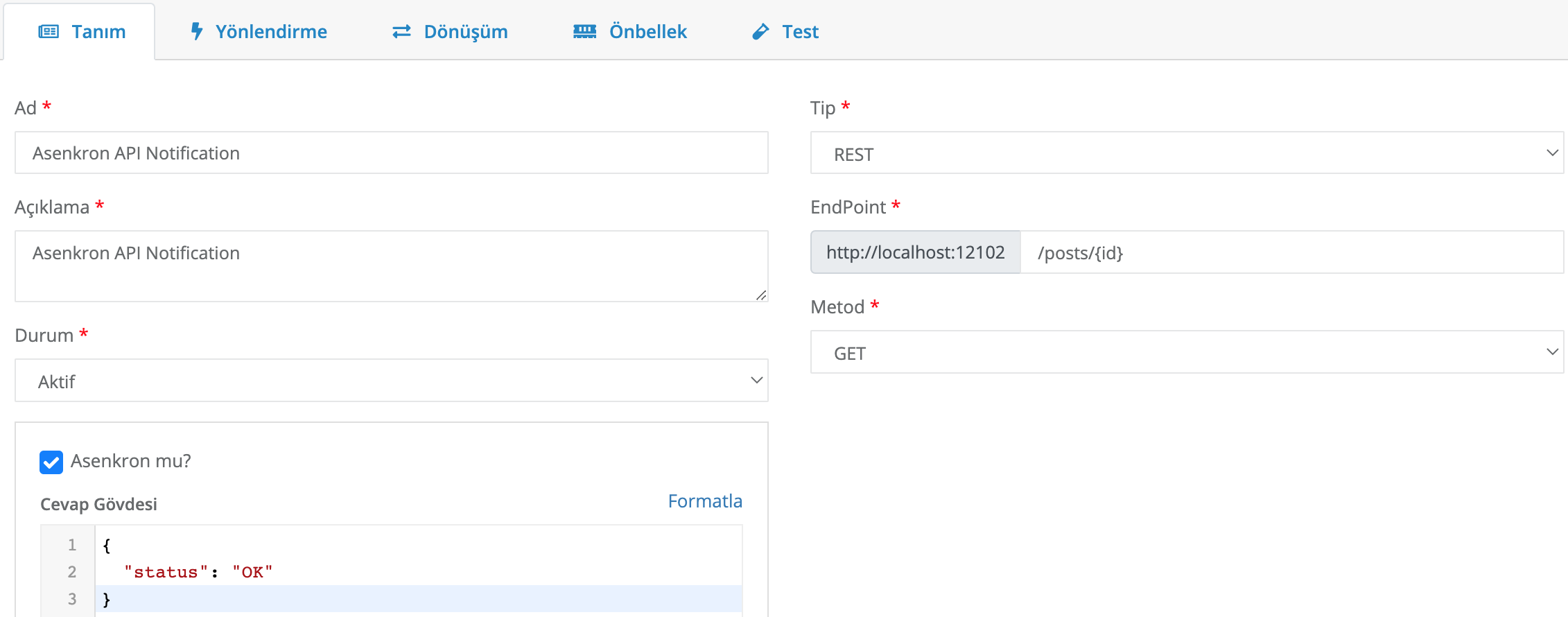
Yönlendirme sekmesine tıklanır ve Basit Yönlendirme seçilir.
Aşağıdaki bilgiler doldurulur:
Backend Http Metot: GET
BackendUri: https://jsonplaceholder.typicode.com/posts/{id}

Sol menüden Katalog altında bulunan API Kullanıcılar'ına tıklanır.
API Kullanıcısı Oluştur butonuna tıklanır.
Aşağıdaki bilgiler doldurulur:
Ad: Test User
Durum: Aktif
Organizasyon: Inomera
Kimlik Doğrulama Yöntemi: Anonim
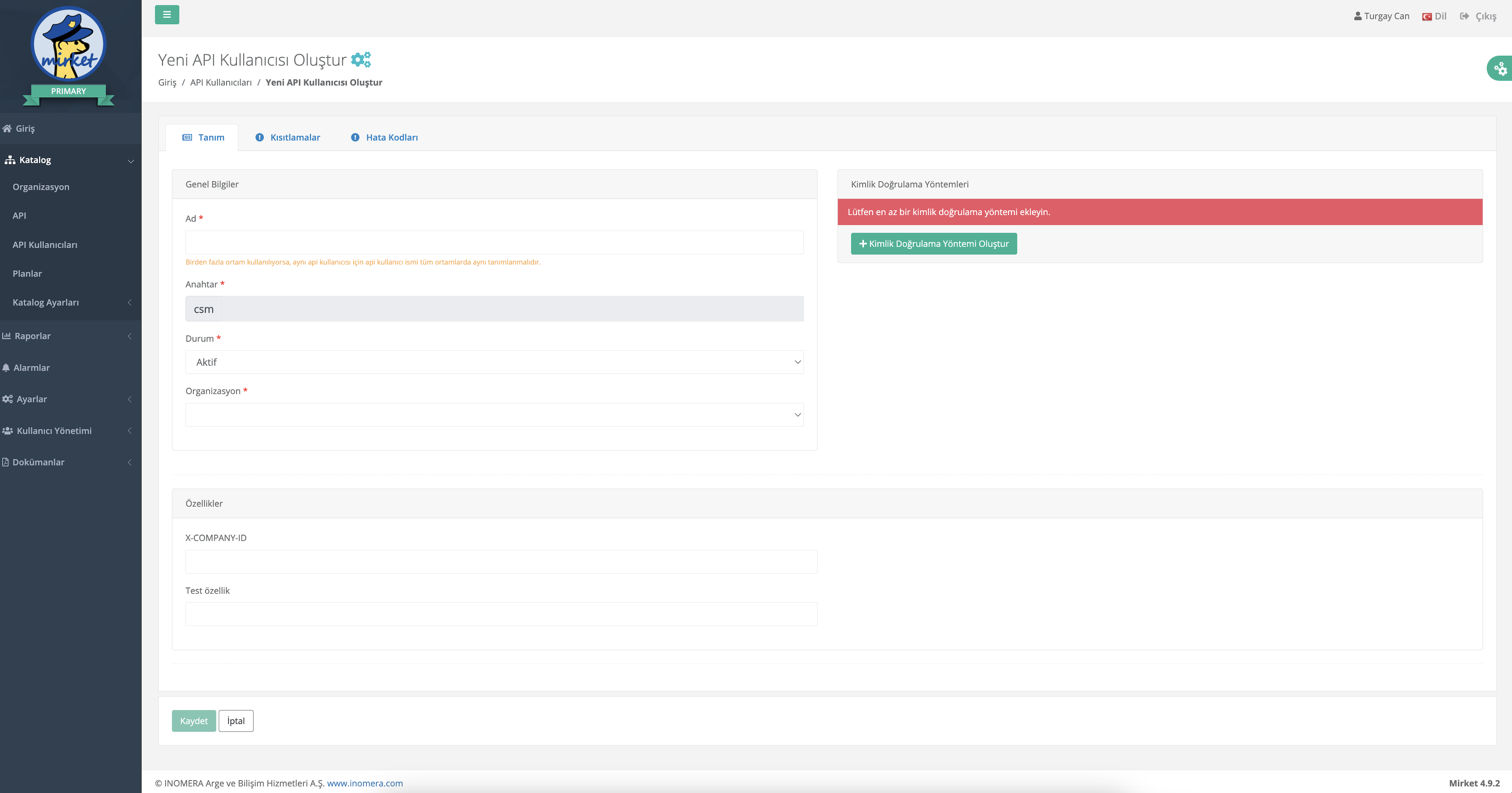
Asenkron API Bildirim Yeniden Denemesi
Sol menüden Katalog altında bulunan Planlar'a tıklanır.
Plan Oluştur butonuna tıklanır.
http://localhost:12107/rest/posts/v10/notif/receive: Backend’de POST isteğini karşılayan Controller’a ait URL olduğu varsayılır.
Aşağıdaki bilgiler doldurulur:
Ad: Client Plan
API Kullanıcısı: Test User
Durum: Aktif
Açıklama: Client Plan
API ekle:
API: Asenkron API Notification
Bildirim Url’i: http://localhost:12107/rest/posts/v10/notif/receive
Bağlantı Zaman aşımı (milisaniye): 1000
Okuma Zaman Aşımı (milisaniye): 1000
Maksimum Deneme Sayısı: 3
Proxy Sunucusu: Proxy Sunucu Kullanılmasın
Zaman Aralığı: 1 dakika
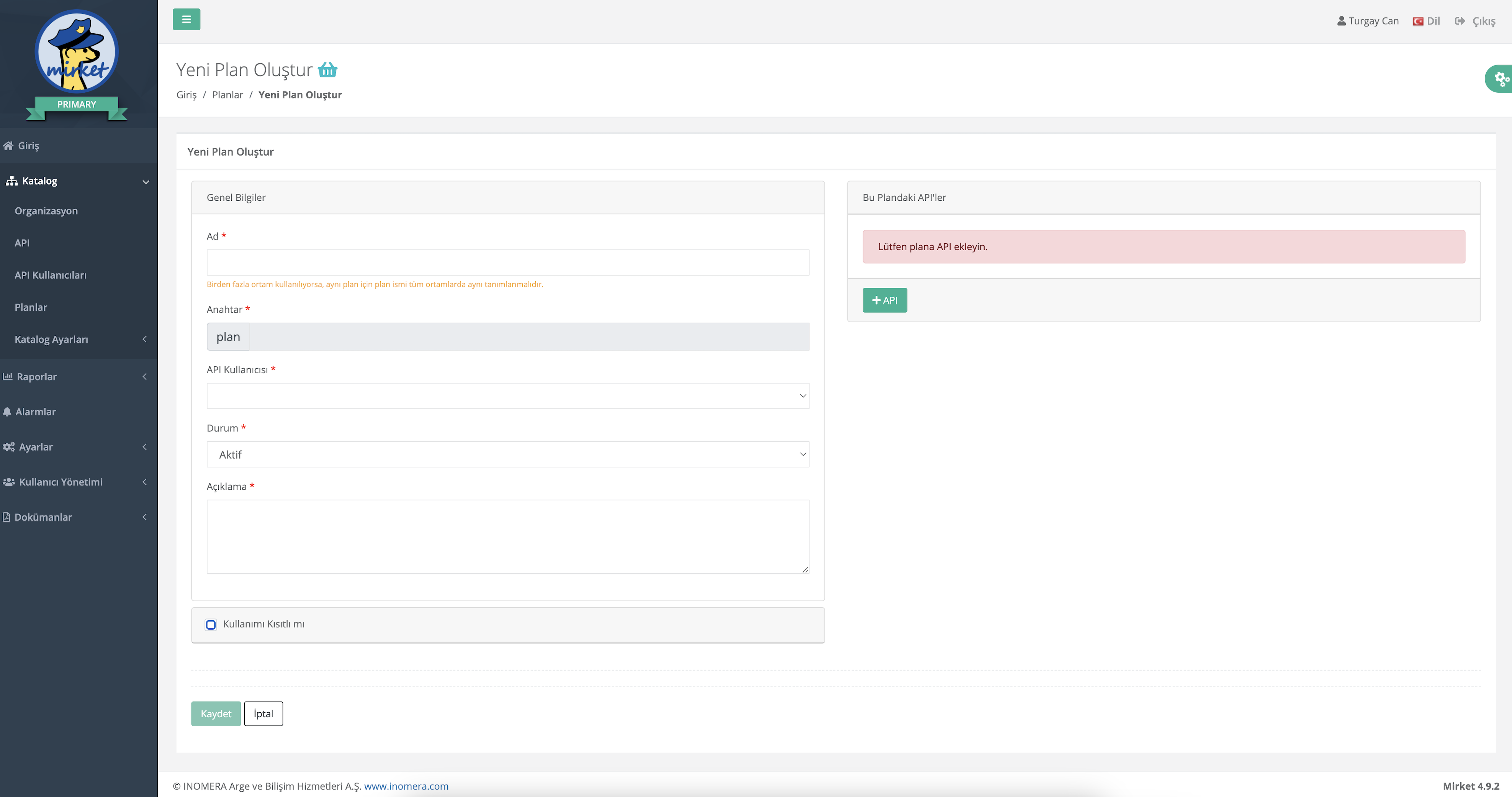
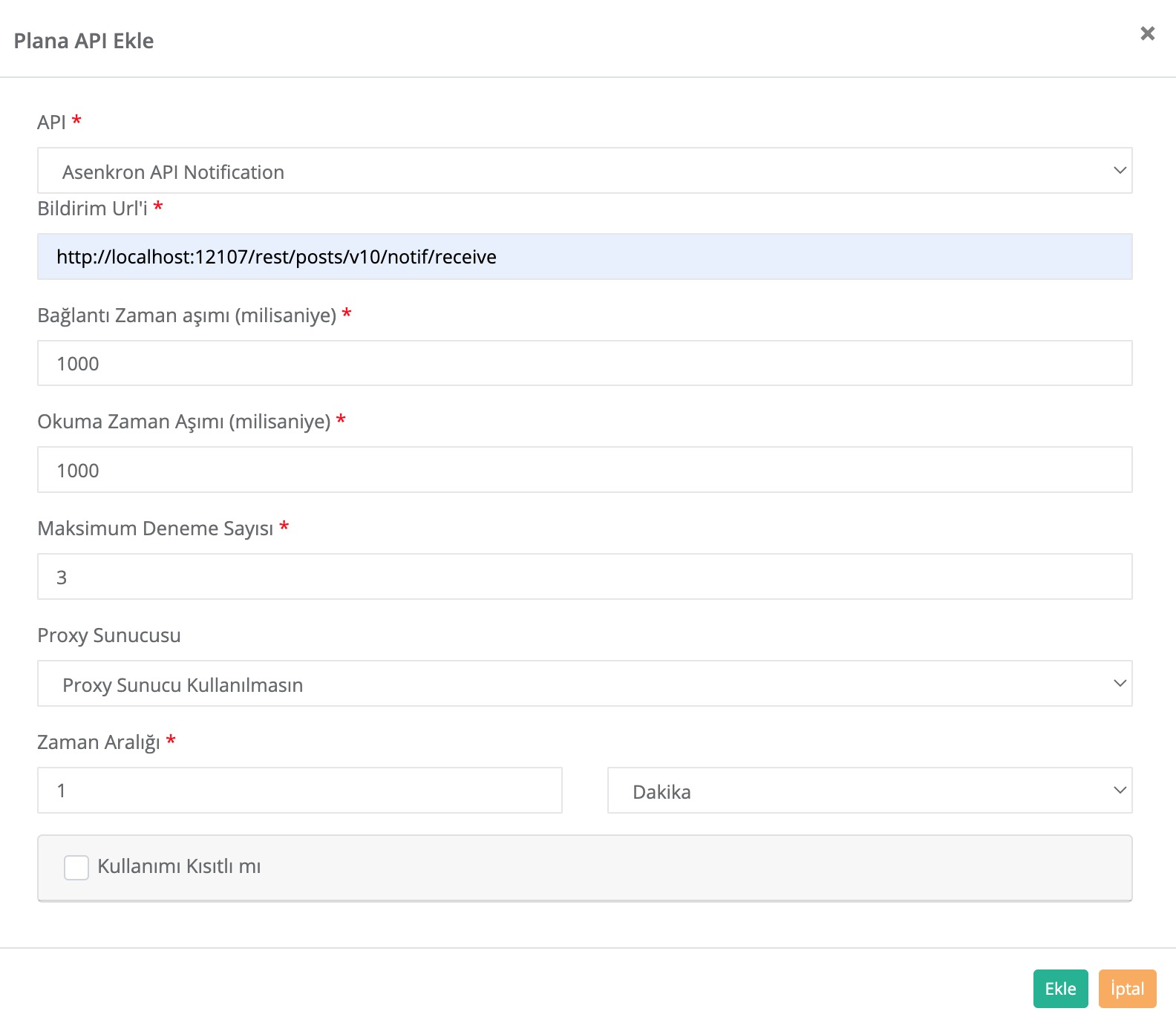
Kaydet butonuna tıklanır.
-
Test
Backend ayakta değilken istek atılır.
Status alanında TO_BE_RETRIED yazdığı görülür.
Sistem tarafından 1 dakika aralıklarla 3 kere istek atılır.
Backend cevap vermez ise status alanı FAILED olarak güncellenir.
Eğer 3 denemeden herhangi birinde backend cevap verir ise status alanı SUCCESSFUL olarak güncellenir.
Asenkron API Bildirim Proxy
Bir adet proxy sunucu kurulur. (Lokalde apache veya bir docker container ile yapılabilir)
Bu proxy sunucunun bilgileri Ayarlar → Proxy Sunucular sayfasından sisteme eklenir.

Sol menüden Katalog altında bulunan Planlar'a tıklanır.
Plan Oluştur butonuna tıklanır.
http://localhost:12107/rest/posts/v10/notif/receive: Backend’de POST isteğini karşılayan Controller’a ait URL olduğu varsayılır.
Aşağıdaki bilgiler doldurulur:
Ad: Client Plan
API Kullanıcısı: Test User
Durum: Aktif
Açıklama: Client Plan
API ekle:
API: Asenkron API Notification
Bildirim Url’i: http://localhost:12107/rest/posts/v10/notif/receive
Bağlantı Zaman aşımı (milisaniye): 1000
Okuma Zaman Aşımı (milisaniye): 1000
Maksimum Deneme Sayısı: 3
Proxy Sunucusu: Apache Local (Proxy sunucunun adı)
Zaman Aralığı: 1 dakika

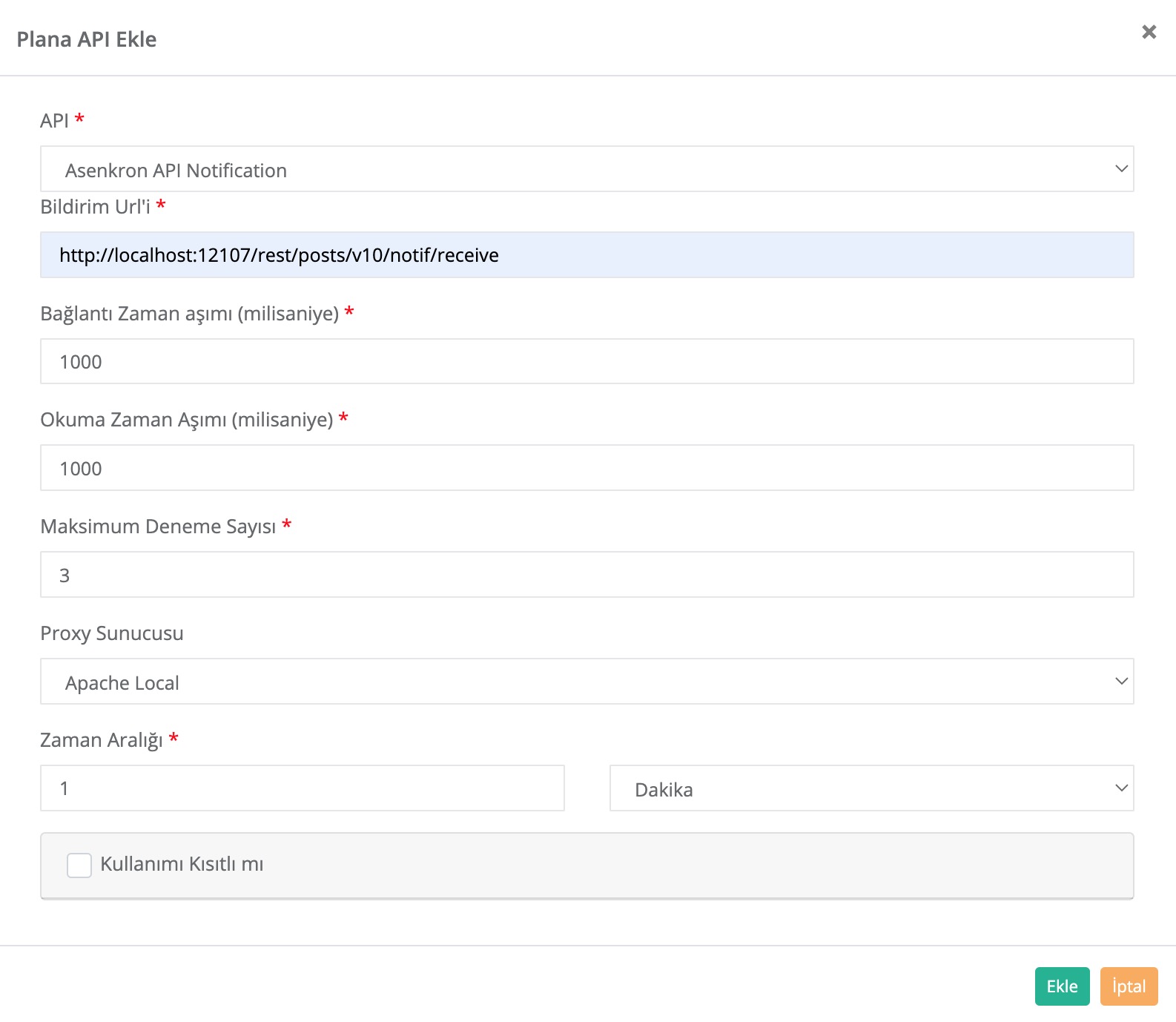
Kaydet butonuna tıklanır.
-
Test
API’ye backend ayaktayken bir istek gönderilir. JSONPlaceholder çıktısının notifikasyon olarak proxy sunucu üzerinden backend’e gönderildiği gözlemlenir.